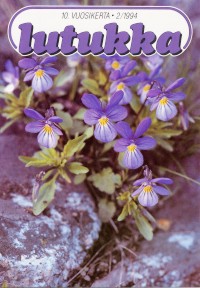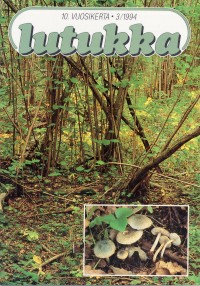Lutukan vuosikerrat 1994–2000
Vuosikerran 16 sisältö (2000)
|
Numero 1/2000
Kirjallisuutta
|
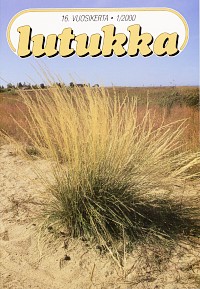 |
Tiivistelmät (englanniksi)
Lehto, M. & Sillanpää, P. 2000: Suomentähtimö Keski-Suomessa – Lutukka 16(1):3–7.
Stellaria fennica - ecology, distribution and vulnerability in central Finland
Stellaria fennica Murb. (Perf.), an eastern boreal herb has its most western peripheral populations in Finland. In the north S. fennica is more common and grows mostly on flooded river banks. In southern Finland it occurs typically on lake shores. The explanation to its current, seemingly random distribution may be hydrochory after the ice age. That time many lakes were connected with each other and formed a single large water body within which seeds were able to disperse. After those days water runoff has diminished and made dispersal inefficient. In addition, stronger species have taken over suitable habitats from this poor competitor. As a result S. fennica has become almost threatened in southern Finland. It can be found in localities where natural disturbances (spring floods, waves) create open spaces. Small-scale human activities on lake shores have also enabled its survival.
Kosonen, L. 2000: Pari harvinaista kasvimuotoa: kerrannaiskukkainen mesiangervo ja erikoinen piharatamo. – Lutukka 16(1):11–12.
Two rare plant forms
Two rare plant forms are reported from the biogeographical province of South Häme. Filipendula ulmaria with double flowers was found in Nokia and Plantago major f. bracteata in Teisko.
Väre, H. & Kaipiainen, H. 2000: Tunturisarake (Kobresia myosuroides) Suomessa. – Lutukka 16(1):13–16.
Kobresia myosuroides in Finland
The only Finnish locality of Kobresia myosuroides was visited in summer 1999. Previous records date back to 1955 and 1956. The growing site is presented and past misunderstandings are corrected in the article. When the population size was counted in 1956 (Laine 1958), Carex rupestris and Kobresia myosuroides were counted erroneously together. Therefore no previous data exist to allow considerations on the development of the population size at Urttasvarri. The nearby population at Liigevarri, found in 1956 also, was reported as disappeared in 1986 (Lammes 1991). Due to mixing of these two species, the meso-eutrophic vascular plant associates presented by Roivainen (1958) based on the work by Laine (1958), are incorrect, representing mainly C. rupestris associates. The K. myosuroides growing site is fairly oligotrophic, dry and stony mountain heath. The population consists of two nearby patches (0.5 and 1.0 m2), with only 18 tufts altogether.
Kääntönen, M. 2000: Peltorusojuuren (Lithospermum arvense) vakiintumisesta Pirkanmaalla. – Lutukka 16(1):17–18.
Lithospermum arvense in Vesilahti and Ylöjärvi, South Häme
Established occurrences of Lithospermum arvense in dry rock meadows were monitored at two localities, in Vesilahti (1987-1999) and Ylöjärvi (1988-1993), in the biogeographical province of South Häme in the southern Finnish inland. The Vesilahti population is still extant in an old-fashioned cultural landscape, but the population in Ylöjärvi has been extinct as a result of overgrowth. The latest record of Lithospermum arvense as a casual in the area was made in 1979.
Godenhjelm, M., Hamari, R. & Hering, F. 2000: Kiintoisia kasvihavaintoja Kotkan Hallan saaresta. – Lutukka 16(1):19–25.
Interesting species records on the island of Halla in Kotka
The small island of Halla near the city of Kotka is a formerly intensively used industrial and harbour area well known for its diverse rural vegetation including a large number of rare neophyte species. A remarkable human impact on the vegetation started already in the 18th century, when the area was under Russian rule and served as a large military camp. In the 19th century sawmills were founded and timber industry started arising rapidly, resulting in a remarkable increase of international trade and shipping. The area has offered excellent growth sites for polemochores, i.e. plants introduced by military operations, plants introduced by sailing ship ballast, as well as numerous other neophytes. The flora comprises threatened species such as Ononis arvensis, Melilotus altissimus and Carex hirta, as well as rare ballast species such as Astragalus glycophyllos and Linaria repens.
Ulvinen, T., Piirainen, M. & Väre, H. 2000: Kasvistotietoja Enontekiöltä. – Lutukka 16(1):28–21.
Floristic notes from Enontekiö Lapland (EnL), northwestern Finland
The paper summarizes new records for the flora of Enontekiö Lapland (EnL), northwestern Finland. Some old records which were not marked in the 3. edition of Retkeilykasvio (Field Flora of Finland) are mentioned, too. The indigenous plants include the following 6 species: Nuphar lutea, Epilobium laestadii, Utricularia ochroleuca, Sparganium natans, Carex acuta and Agrostis gigantea (also an immigrated race). The record of Equisetum hyemale × variegatum has been found erroneous.
In the group of the immigrants Urtica urens is regarded as an established alien. It is still growing at Markkina village where it has been seen since the mid-1800s. Also Thlaspi caerulescens ssp. caerulescens, Alchemilla monticola and probably Festuca trachyphylla seem to be established. Other 14 aliens include e.g. Herniaria glabra, Alchemilla glaucescens (an old problematic record), Lotus corniculatus, Bromus secalinus and Phalaris canariensis. As garden escapes Aconogonon alpinum × weyrichii, Campanula glomerata var. dahurica, Rosa majalis and maybe Mentha arvensis have been collected.
|
Numero 2/2000
Kasvihavaintoja
Kirjallisuutta
|
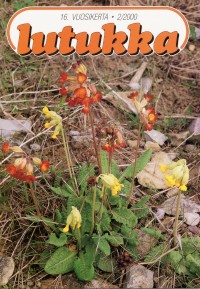 |
Tiivistelmät (englanniksi)
Hinneri, S. & Santamala, E. 2000: Rantaputki Uudenkaupungin ja Kustavin (V) sekä Kumlingen (A) saaristoissa. – Lutukka 16(2):43–46.
New records of Ligusticum scoticum in SW archipelago of Finland
In addition to earlier records of Ligusticum scoticum in Finland (the biogeographical provinces Åland, Satakunta, South Ostrobothnia and Uusimaa) the first two localities (Uusikaupunki and Kustavi) for Varsinais-Suomi and a new occurrence for Åland are presented. The ecological conditions of the localities are described in detail. All the localities of the species adapted to low summer temperatures are on west-facing seasides exposed to physical stresses caused by cold winds, rolling waves and ice pressure. The ecological conditions are fairly similar as presented for this species on northern coastlands and islands of the British Isles where it avoids sites characterized by a warm microclimate. Although the species is obviously spreading in the southern and western archipelagoes of Finland, the proceeding warming of the climate owing to the greenhouse effect may prevent the expansion in the future.
Hintikka, V. 2000: Helsingin Vuosaaren metroradan rakennustöissä tuhoutunutta kasvilajistoa. – Lutukka 16(2):47–49.
Plant localities destroyed by the building of Vuosaari metro railway in Helsinki
When the metro railway was built in Vuosaari, eastern Helsinki, in 1995-98, occurrences of Holcus mollis and Allium oleraceum were destroyed. As the latter occurrence was situated near an ancient sailing route by vikings and near a prehistoric castle hill, the occurrence was regarded to be of ancient origin.
Kurtto, A. & Helynranta, L. 2000: Helsingin kasveja 3. Pehmytmesiheinä. – Lutukka 16(2):50–54.
Vascular plants of Helsinki 3. Creeping Velvet-grass, Holcus mollis
Creeping Velvet-grass (Holcus mollis L.), a native of Central and southern Europe, belongs to the fairly large group of established grass seed immigrants in Finland. Most of the stands, including all extensive ones, of the species in Helsinki are clearly connected with previous fields. Thus, the principal vector has been fodder grass seed. Some mostly smaller stands originate from impurities of seed used for road banks and cuttings or for so-called English parks of villas and manors. Many stands have survived even in overgrown habitats, since the plant is vegetatively vigorous and originally a forest-dweller in its native range.
The earliest Finnish record of Holcus mollis dates back to 1903 (introduced with Russian oats seed), and the earliest for Helsinki to 1923. The chronological distribution of herbarium specimens and other records seem to indicate that the peak of immigration began as late as in the 1940s and that it is still continuing. However, the earliest stages of immigration may have largely escaped notice due to the rather unpretentious habit of the grass and to lowered floristic activity in the 1920s and 1930s. In any case, the rapid accumulation of new records of roadside stands during the last few decades is a sign of a new wave of immigration, which is, contrary to the prevailing situation in earlier times, independent of agriculture and thus capable of dispersal even to outlying regions unsuitable for cultivation.
Piirainen, M. & Lampinen, R. 2000: Uusia meriratamon tienvarsilöytöjä. – Lutukka 16(2):62–63.
Plantago maritima - new roadside localities
New roadside localities of Plantago maritima are reported from Finland. After these new records the species is known on roadsides in 9 biogeographical provinces and 29 communes, eight of which are inland communes. In 1999, it was found for the first time in an inland province, North Häme. The plant seems to be spreading on.
Floristic notes – Lutukka 16(2):60–61
-
Amaranthus powellii is reported in Juuka, as new to the biogeographical province of North Karelia. It was found as a casual introduction in a garden, where birds had been fed. - J. Räsänen
-
Scabiosa columbaria was found on a newly sown lawn in Liperi, North Karelia, with some other rare and mainly casual species in the province. S. columbaria has been found earlier only a few times in Finland. - J. Räsänen
-
Euphrasia nemorosa is reported from three localities in North Karelia, where the species is very rare. All the records were made on roadsides or other ruderal sites. - J. Räsänen
-
Chenopodium schraderianum was found in a snow and soil dump area in Lahti town, S Finland. There was a dense stand with 80 stems, the tallest almost 1 m. There are only four previous records of the species in Finland, either cultivated or as a weed in gardens. - P. Horppila
|
Numero 3/2000
Kasvihavaintoja
Kirjallisuutta
|
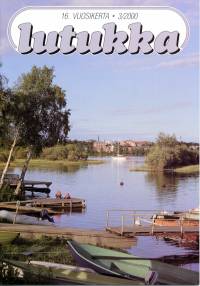 |
Tiivistelmät (englanniksi)
Väre, H., Ulvinen, T., Vilpa, E. & Kalleinen, L. 2000: Oulujoen suiston kasvisto ja uhanalaislajisto. – Lutukka 16(3):67–87.
Vascular flora of the River Oulujoki estuary, northern Finland
Vascular flora of the River Oulujoki estuary was studied in 1999 and 2000, including 34 islands of various size. In addition adjoining shores of the mainland were investigated. In total 380 species were discovered on the islands, of which 220 are considered as native in the area. In the article a special attention is paid to aquatic species, shore line species and threatened plants.
The estuary area is exceptionally rich in species in comparison to areas of similar size in Ostrobottnia ouluensis biogeographical province, in spite of the river area having been built in the 1950's. This is due to continuous vegetation succession of the islands due land uplift in the area (8 mm/yr), nutrient rich substrate brought in by the river and the centennial human impact. However, 19 threatened species in total have disappeared already. This is mainly due to construction of the environment and changes in agriculture.
However, the aquatic plants are still well represented, including e.g. Alisma wahlenbergii, Callitriche spp., Crassula aquatica, Elatine spp., Limosella aquatica, Myriophyllum spp., Potamogeton spp., Ranunculus confervoides, R. peltatus, Subularia aquatica, Utricularia spp. and Zannichellia palustris var. repens. As the distribution maps indicate, certain species are confined to outer shores of higher salinity (only 3 ‰ however) while the others are confined to the inner estuary with lower salinity. The outer shores have a harder sandy bottom. Only a few species thrive on both kind of shores, e.g. Callitriche palustris, Elatine hydropiper and Subularia aquatica. Persicaria foliosa has one of its richest populations in Finland within the estuary. This species, as well as Alisma wahlenbergii, are listed in Annexe II of the European Commission Habitats Directive, indicating their rarity in Europe. To summarize, the Oulujoki estuary shows very high vascular plant diversity which must be taken into the account in land management plans.
Vilpa, E. & Ulvinen, T. 2000: Suomen pohjoisimmat tikankontit ja suoneidonvaipat. – Lutukka 16(3):88–89.
The northernmost Finnish localities of Cypripedium calceolus and Epipactis palustris
The paper presents the northernmost localities of Cypripedium calceolus (in Kittilä, Kittilä Lapland) and Epipactis palustris (in Rovaniemi rural commune, Outer Ostrobothnia). Both species grew in an eutrophic fen with pines. The former site was untouched but the latter had been drained many years ago.
Saarinen, K. & Jantunen, J. 2000: Lappeenrannan kalkkitehdasalueen tulokaslajisto komistui. – Lutukka 16(3):92–93.
Epipactis atrorubens as a newcomer in the limestone quarry in Lappeenranta, SE Finland
The area influenced by calcareous dust from the limestone quarry in Lappeenranta is characterized by several rare plant species, orchids in particular. The orchid flora consists of at least 15 species found during the last two decades. In July 2000, the threatened Epipactis atrorubens was found for the first time in SE Finland among the several hundred individuals of Epipactis helleborine. The field layer of this quite luxurious pine heath was dominated by Platanthera bifolia, Fragaria vesca, Calamagrostis epigejos, Convallaria majalis and Antennaria dioica, among others. The species is most probably a newcomer having arrived by wind.
Floristic notes – Lutukka 16(3):93–95
-
Torilis japonica is reported from a former sawmill area in Tampere, South Häme. Ca. 200 specimens of the species were found in a shrubbery and along its margins. The history of the occurrence is somewhat mysterious, and also the possibility of intentional spreading is discussed, but it is considered unlikely. Outside its native area in the Åland Isles the species has been found as a casual only a few times. – M. Kääntönen
-
Ceratophyllum submersum is reported from Lemland as new for the biogeographical province of Åland. It was abundant in a pool and an almost isolated brackish water bay on the remote island of Lågskär, which is a well-known resting place for migrating birds. The find is the second from Finland, and from a similar resting place for waterfowl as the first find (Uusimaa, Espoo, Suomenoja) in 1999. – K. Hiironniemi
|
Numero 4/2000
Kasvihavaintoja
|
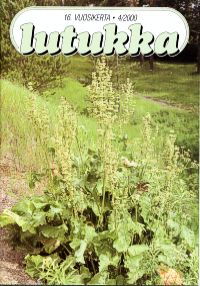 |
Tiivistelmät (englanniksi)
Saarinen, K. 2000: Lappeenrannan vanhan rautatien venäläiskasveja ja muita tulokkaita. – Lutukka 16(4):99–105.
Russian polemochores and other immigrants along an old railway in Lappeenranta, SE Finland
The first railway to Lappeenranta was constructed in 1885. During the first decades, the traffic mostly consisted of goods trains and Russian military troops. Corn and fodder were imported for the use of Russian troops and their horses. The paper describes the present status of Russian polemochores, which immigrated with the goods trains, and other immigrants of the later periods, along an old railway in the middle of Lappeenranta town. Three kilometres of the tracks remain today and still, after a century since their arrival, a large number of Russian immigrants are thriving there. Species such as Berteroa incana, Bromus inermis, Euphorbia esula and Bunias orientalis have become even more abundant and spread out to wider areas, while Rumex confertus, Carex praecox, Trifolium montanum, Convolvulus arvensis and Medicago sativa ssp. falcata have survived only along the railway. The vegetation on the embankments is characterised by many later railway immigrants (Chaenorhinum minus, Conyza canadensis, Lepidium densiflorum, Senecio viscosus) as well as escapes from cultivation, such as Armoracia rusticana, Campanula rapunculoides, Geranium pratense and Saponaria officinalis.
Piirainen, M. & Piirainen, P. 2000: Kasvikuulumisia muutamilta Kuhmon talvisodan aikaisilta taistelupaikoilta. – Lutukka 16(4):106–117.
Notes from a few Winter War time Russian campsites in Kuhmo, E central Finland, in 1997
Kuhmo commune in the biogeographical province of Kainuu, E central Finland, saw heavy fighting during the Finnish-Russian Winter War in 1939-1940. Large Russian troops were closed into several encirclements. The Finnish army could not take over the largest ones, and Russian troops stayed in them for about three and a half months. The Russians had many horses as chargers and draught animals, and fodder for them was freighted from Russia. After the war, a varied range of polemochorous vascular plants was recorded in the area. Many of them, especially annuals such as Fagopyrum esculentum, Sisymbrium loeselii, Asperugo procumbens and Panicum miliaceum, were found only once, in 1941. Most of the specimens in Finnish herbaria seem to have been collected in the 1950s and 1960s, but mainly single specimens have also been collected up the 1990s.
We visited some of these Russian campsites in 1997. Several polemochores were still extant. Among the most interesting we found were many species of Alchemilla. The only known Nordic locality of A. leiophylla is in Riihivaara in Kuhmo, where it was also found by us. A. semilunaris was met in two of our localities. It had been found in the Nordic countries only from a few sites in Kainuu until 1999, when it was also found as a Russian polemochore in Norway, Sør-Varanger commune in E Finnmark by the first author of this article. In addition, A. glabricaulis is known in the Nordic countries only from some Russian wartime campsites in Kainuu. We failed to find several of the polemochores recorded earlier, but the time we used was so limited that no conclusions can be drawn as to the possible status of these taxa.
Several species we found in Kuhmo had been marked as casuals in the third edition of the Field Flora of Finland (Hämet-Ahti et al. 1998, Retkeilykasvio). After growing for almost 60 years in the area, they are now considered as established aliens. These include Stellaria hebecalyx, Dianthus superbus, Bistorta major, Rumex thyrsiflorus, Alchemilla hirsuticaulis, A. heptagona, A. semilunaris, A. leiophylla, A. glabricaulis and Ajuga reptans.
Jantunen, J., Saarinen, K. & Marttila, O. 2000: Pientareet niityiksi Imatran uudella moottoritiellä. – Lutukka 16(4):119–126.
The establishment of meadows along motorway sides in Imatra, SE Finland
The sandy ramps of the new Imatra motorway were (1) sowed by seeds of meadow plants (one ramp) and (2) covered with the plant debris mown from a nearby meadow (two ramps). In addition, (3) one ramp with nutrient rich soil was only managed by mowing and grazing sheep. Two years afterwards, the meadow vegetation covered, on average, 22 % (autumn sowing) and 8 % (spring sowing) of the sample plots (2 × 2 m2). Correspondingly, the mean coverages were 16 % (<3 cm humous soil spread) and 28 % (<10 cm humous soil spread) in the sample plots of ramps covered with the mowed debris. The most abundant species on these ramps were Leucanthemum vulgare, Dianthus deltoides and Epilobium angustifolium. The third area, grazed by sheep, was still too rich in nutrients for the meadow vegetation. The vegetation was mostly dominated by Tussilago farfara, Agrostis capillaris and Cirsium arvense. The mean coverage of all plants in the sample plots was 86 %. When taking good care of all three sites, a favourable development towards a diversified meadow flora should occur in the future.
Floristic notes – Lutukka 16(4):117–118
-
The only known locality of Cladium mariscus in the Finnish mainland is situated in Joroinen, the biogeographical province of North Savo. The species is regarded as vulnerable in the country. The growing site, a rich fen, was dug with ditches in 1970. Cladium seems to have suffered from the subsequent lowering of the groundwater level, and Saxifraga hirculus has disappeared from the locality after the beginning of the 1980s. The population of Cladium was inventoried during the summer 2000, in order to plan the management of the locality. 111 fertile and ca. 430 sterile shoots were found in an area of ca. 40 m². First trees were felled during the autumn to enable the filling of the ditches, and further fellings are planned to restore the original character of the site. – M. Vauhkonen
Vuosikerran 15 sisältö (1999)
|
Numero 1/1999
Kasvihavaintoja
|
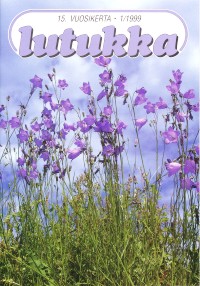 |
Tiivistelmät (englanniksi)
Jantunen, J. & Saarinen, K. 1999: Laidunnuksen vaikutus niittykasvillisuuteen. – Lutukka 15(1):3–12.
The effects of grazing on meadows and their vegetation
Traditional agricultural biotopes such as meadows, wooded pastures and grazed forests have existed and maintained by continuous hay mowing and grazing. In 1994 we studied the effects of grazing by comparing seven grazed, six formerly grazed but abandoned and five never grazed open meadows (n=18). The vegetation data of each meadow was collected from seven 2 × 2 square metre sample plots (n=126). Multivariate analysis (TWINSPAN, CCA-ordination) were used in the study. The plant species favoured by grazing were also determined.
The results indicated too intensive management (overgrazing and nutrient enrichment) on grazed sites. The vegetation in recently abandoned meadows (total of 94 species) appeared to be more diverse than in the meadows of much longer abandonment (75 species) or present use (57 species). As indicated by multivariate analysis, the management was the most important factor affecting the vegetation of a meadow. Other important variables were the quality and the structure of the ground. Due to the small number of grazed sites the species favoured by grazing were difficult to determine. For example, Artemisia vulgaris, Carum carvi and Potentilla argentea were concentrated on grazed sites although they are not regarded as species adapted to grazing. However, when studied with CCA-ordination, several species were noticed to concentrate on grazed sites. These species included Alchemilla monticola, Campanula rotundifolia, Festuca ovina, Leontodon autumnalis, Leucanthemum vulgare, Nardus stricta, Pimpinella saxifraga, Plantago major, Bistorta vivipara, Prunella vulgaris, Trifolium repens and Veronica officinalis.
Uotila, P. 1999: Näiveitä Helsingin yliopiston kasvitieteellisessä puutarhassa Kaisaniemessä. – Lutukka 15(1):13–15.
Three different Broomrapes (Orobanche) in the Helsinki Botanical Garden
Three unintentionally introduced or spontaneously spread species of Orobanche, O. crenata, O. lucorum and O. hederae, were found in the Botanical Garden of the University of Helsinki, Finland, in the 1990s.
Jutila, H. 1999: Uusia kämmekkähavaintoja Satakunnasta. – Lutukka 15(1):16–21.
Orchid records from the province of Satakunta, W Finland
The declining Coeloglossum viride was found in eight localities in North Satakunta. Most of the sites were old woodland pastures grazed up to present times. 234 individuals of Coeloglossum viride were found in the area accompanied by a rich and variable flora. Most common associate species were Fragaria vesca, Veronica chamaedrys and Viola riviniana. The population size and flowering of Dactylorhiza incarnata ssp. incarnata was monitored in Pori in 1992 to 1998. The largest number (311) of flowering plants was found in 1998. It seems that the population is moving towards the sea, but still keeping at the same elevation as the land uplift creates new land. The most common associating species were Carex nigra, Calamagrostis stricta, Festuca rubra, Myrica gale and Filipendula ulmaria. A new locality for Epipactis helleborine was found in a road ditch and verge in a rich wood in Eurajoki in 1995. In 1998 there were 25 specimens at the site. Also some localities for Gymnadenia conopsea, Corallorhiza trifida and Listera cordata are reported.
Ranta, P. 1999: Ketoraunikki (Gypsophila muralis) leviämässä kaupunkeihin. – Lutukka 15(1):22–23.
Gypsophila muralis as a neophyte in three towns in S Finland
Gypsophila muralis was found as a probable established neophyte at several sites in Tampere, Kerava and Järvenpää in 1998. The plant seems to be an escape from cultivation in these localities. The seed of cultivated plants probably originates from Denmark. It seems possible that the species will spread further in the near future, if its cultivation continues. Gypsophila muralis has earlier been known as a rare and threatened archaeophyte in Finland, with also several casual occurrences.
Fagerstén, R. 1999: Lisätietoja idänlehväsammalesta (Plagiomnium drummondii) Suomessa. – Lutukka 15(1):30–21.
Complementary records of Plagiomnium drummondii in Finland
Fifteen new finds of Plagiomnium drummondii (Bruch & Schimp.) T. Kop. in Finland since Fagerstén (1981b) are recorded, among them both the westernmost (26°45' E) and the northernmost (63°22' N) ones in Fennoscandia. The westernmost find is also new for the province North Häme (PH/Tb). A completed map is represented. As a rare moss of the last and virgin, mainly eutrophic grass-herb forests, it is threatened by the forest management activities. However, it has been found to belong to the flora of six conservation areas.
Floristic notes – Lutukka 15(1):23–26
-
An exceptionally large stand of white-flowered Hepatica nobilis is reported from Rääkkylä commune, eastern central Finland (North Karelia biogeographical province). The species is growing here at its northern limit in the country, and most of the local occurrences, including the reported one, are remnants of or escapes from cultivation. The stand comprises of more than 500 specimens, and not a single one of them has the normal blue flower colour. – H. Eskonen
-
A short-lived occurrence of the vulnerable Elatine alsinastrum was found in Nokia, southern Finland (South Häme province). The origin of the stand has probably been in a local seed bank exposed by digging of a small irrigation water pit. – L. Kosonen
-
Floristic information is given from the southern Finnish town Heinola (South Häme province). The locally rare Carex spicata was re-found in 1998, but the locality was later cleared for building purposes. Geranium bohemicum was found in a locality where twigs were burned after clearing a rich forest area for nature conservation purposes. It seems possible that the seed bank has been untouched for well over one hundred years. Exceptionally tall specimens of Lappula deflexa, Campanula cervicaria, Platanthera bifolia and Epipactis helleborine seem to be caused by the rainy summer in 1998. – M. Vauhkonen
|
Numero 2/1999
|
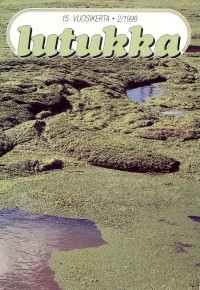 |
Tiivistelmät (englanniksi)
Uotila, P. 1999: Kupulimaska (Lemna gibba) Suomessa ja kupulimaskan massaesiintyminen Porvoonjoessa. – Lutukka 15(2):35–42.
Lemna gibba (Lemnaceae) in Finland, and the mass occurrence of L. gibba in the river Porvoonjoki, S Finland
Late in the summer of 1997, a mass occurrence of Lemna gibba L. (Lemnaceae) was observed in the river Porvoonjoki, S Finland. Bright green floats of L. gibba covered the river 40 km upstream from the mouth. The floats were dozens to hundreds of meters long and often covered the whole width of the dozens of meters wide river. An estimate of the total weight of the mass was one thousand tons. Summer 1997 was exceptionally warm and dry in the catchment area of the river. The water in the river was warm and the velocity low. The river Porvoonjoki is one of the most heavily eutrophied rivers in Finland. Hence, the circumstances for such a mass occurrence were particularly favourable. Probably L. gibba has grown in the river for some years, but such a mass occurrence has not taken place earlier.
One year earlier Lemna gibba was recorded for the first time from a small eutrophic pond, Maari (a former river bay) in the town of Porvoo on the lower course of the river Porvoonjoki. However, it was not found in Maari in the late 1980s and in earlier decades when the flora of the pond was studied several times. In 1997, L. gibba flowered and produced fruits in Maari, which was still warmer than the river. No flowers or fruits were found from the river Porvoonjoki. No earlier flowering or fruiting specimens of L. gibba have been collected in Finland.
The origin of Lemna gibba in either the river Porvoonjoki or the Maari pond is not known, but most probably it is in the southeast, in the Leningrad Region of Russia, where L. gibba has been known for decades. Casual L. gibba, floating from the east, has been reported on the southeastern Finnish coast of the Gulf of Finland in Virolahti (1968), and in Porvoo (1975 and possibly already before the 1950s).
For the first time Lemna gibba was with certainty found in Finland in 1911, from eutrophic rock pools on the outer islands of the Åland archipelago in the southwest. Since then it has been reported as established further and further east in the archipelago, in the 1990s up to Inkoo, west of Helsinki. In addition, there are casual finds also in the southwestern coastal mainland in Turku (1948).
Lampinen, R. & Lahti, T. 1999: Kasviatlaksen 15. kuuma kesä. – Lutukka 15(2):43–48.
Atlas of the Distribution of Vascular Plants in Finland: the 15th summer
The third version of the digital Atlas of the distribution of the vascular plants in Finland is planned to be available in 2000. The recent progress of the project is elucidated, with a description of the recent and planned additions to the national floristic database, and with thoughts on various ways for improving the uneven coverage of the database. We suggest 1) thorough 1 sq-km inventories of areas so far poorly covered by the atlas (to be used for estimating the regional frequency), 2) less complete field lists in areas poorly covered by the national floristic database (to be used for improving the 10 km × 10 km dot distribution maps), 3) repeated, thorough inventories of 1 sq-km grid cells by several independent people during one season (to be used for estimating the values for how different taxa are observed).
Leikkonen, M. 1999: Ajankohtaiset kevätleinikit. - Lutukka 15(2):49–57.
Some comments on the study of Ranunculus auricomus agg. in Finland
The apomictic Ranunculus auricomus L. s.l. comprises of more than 300 agamospecies in Finland, and probably many taxa still remain undescribed. The group was studied on a large scale in the mid-1900s in the country, and more than 40 000 herbarium specimens were collected for the Botanical Museum of the Finnish Museum of Natural History. The tradition has seized later, and no serious work has been done during the last decade. Earlier, the group was handled as subspecies of four collective species, R. auricomus, R. fallax, R. cassubicus and R. monophyllus, but it seems well-founded to treat them at the species level like in several other apomictic groups.
This article reviewes the Finnish tradition in the study of R. auricomus, the apomictic breeding system and the biogeographical aspect connected with the large amount of taxa within the group. The lack of a summary of the taxa described in numerous separate articles, and especially the difficulty to produce any identification key makes it hard for a beginner to start working with the group.
The author gives an account of his own experience, and demonstrates some common species in his own study area in southwestern Finland.
Uotila, P. 1999: Onkohan Suomessa etelänhaarapalpakkoa? – Lutukka 15(2):57–60.
Does Sparganium erectum ssp. erectum grow in Finland?
The European fruit-morph subspecies of Sparganium erectum L. are briefly characterized. Several specimens, collected from various parts of Finland, the first ones in 1854, have been determined to S. erectum ssp. erectum or suspected to be intermediates between ssp. erectum and ssp. microcarpum. Their fruits are relatively small and their morphology is not so typical of ssp. erectum from more southern areas. This and the usually high sterility percentage indicate that at least part of them may be intermediates between ssp. erectum and ssp. microcarpum rather than ssp. erectum. The most prominent of such specimens at H are listed. A recommendation is given to make observations and to collect better specimens from clones of S. erectum with poor fruit production.
Uotila, P. 1999: Itulimaska (Lemna turionifera) Suomessakin. – Lutukka 15(2):61–63.
Lemna turionifera (Lemnaceae) found in Finland
Lemna turionifera Landolt is reported for the first time in Finland, in the southwestern outer archipelago. Two herbarium specimens, collected from Åland, Jomala in 1966 (one year later than the first find in Central Europe) and in V Korppoo in 1973, both named as L. minor, were identified in spring 1999 to L. turionifera. So far only part of the Finnish herbarium material has been checked for L. turionifera, and probably the species is more common in southwestern Finland.
|
Numero 3/1999
Kasvihavaintoja
Kirjallisuutta
|
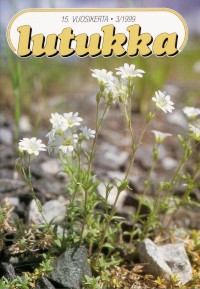 |
Tiivistelmät (englanniksi)
Ulvinen, T. & Varkki, A. 1999: Uusia tietoja Pohjois-Suomen kasvistosta 2. Tulokaskasveja ja viljelykarkulaisia. – Lutukka 15(3):67–90.
New records for the northern Finnish flora 2. Immigrants and escapes of cultivated plants
The paper summarizes new records for the not-indigenous plants (immigrants/escapes) in northern Finland, from the following biogeographical provinces: Kainuu (Kn) 44/17, Oulun Pohjanmaa (OP) 24/10, Perä-Pohjanmaa (PeP) 38/10, Koillismaa (Ks) 13/6, Kittilän Lappi (KiL) 28/12 and Sompion Lappi (SoL) 20/2. These include old "ballast" plants, e.g. Cakile maritima ssp. maritima (PeP) and Linaria loeselii (OP, 1885-1890 Oulu, the sole records from Finland), other harbor plants, e.g. Senecio aquaticus (OP) and Centaurea trichocephala (PeP, 1923 Kemi, the older of the two records from Finland), plants of the roadsides mostly distributed by grass seed, e.g. Silene noctiflora (PeP), Lepidium ramosissimum (Kn), Puccinellia distans ssp. borealis (Kn) and Bromus tectorum (Kn) and railroad plants, e.g. Consolida regalis ssp. regalis (Kn, Ks), Camelina microcarpa (Kn), Conyza canadensis (PeP) and Puccinellia distans ssp. distans (KiL). Also the endemic Artemisia campestris ssp. bottnica has spread along railroads to Kn and KiL. A number of immigrants are German polemochores from wartime in the 1940's, e.g. Ranunculus nemorosus (PeP), R. acris ssp. friesianus (Kn), Thalictrum minus ssp. kemense (SoL), Thlaspi caerulescens ssp. caerulescens (SoL), Primula elatior (Ks, KiL), Potentilla aurea (PeP), P. thuringiaca (KiL), Alchemilla glaucescens (SoL), A. propingua (KiL), Phyteuma spicatum (Kn), Cirsium oleraceum × rivulare (PeP, the only record from Finland), Dactylorhiza majalis (Kn), Carex disticha (Kn) and Poa chaixii (OP).
The field weeds include e.g. Sanguisorba officinalis (Kn), Vicia villosa ssp. varia (OP), Vicia ervilia (Kn, 1935, the oldest record from Finland) and Trisetum flavescens (Kn), and to the garden weeds belong e.g. Cerastium glomeratum (OP) and Ammi majus (SoL). Some plants have spread together with seeds for the birds, e.g. Datura stramonium (OP, PeP), Ambrosia artemisiifolia (OP), Carthamus tinctorius (Kn) and Echinochloa crus-galli (Kn). Some immigrants have been found from dumping places and landfill areas, viz. Gypsophila muralis (OP), Arabis divaricarpa (OP, Oulu, the only record from Finland), Physalis ixocarpa (OP) and Phalaris canariensis (Kn, KiL).
Elodea canadendis has been found abundantly in new areas (OP, Ks). Gentianella campestris grew on a meadow (OP, 1915). Today it is considered as extinct from the province. Dianthus barbatus × superbus has been found as a spontaneous hybrid in KiL.
The escapes of cultivated plants include garden herbs, e.g. Actaea rubra (Kn), Thalictrum minus ssp. kemense (KiL), Aconogonon alpinum × weyrichii (KiL), Alchemilla glaucescens (KiL), Fragaria muricata (Kn), Thermopsis montana (KiL), Polemonium caeruleum (Ks, KiL), Dracocephalum sibiricum (Kn, OP, PeP) and Centaurea montana (Kn, OP), and shrubs, e.g. Sorbaria sorbifolia (Kn, KiL), Amelanchier spicata (Kn), Lonicera caerulea (OP) and Sambucus racemosa (PeP).
Some corrections are made, too. The records of Arenaria serpyllifolia from PeP and Euphorbia esula from KiL seem to be erroneous. No evidence for a record of Herniaria glabra in Kn has been found.
Floristic notes – Lutukka 15(3):90–93
-
Ceratophyllum submersum was found in a temporarily used wastewater basin in Espoo, S Finland. It was abundant and the only submerged plant in this former inlet, which has been known for a long time as a good place for bird watching. The plant has probably been brought here by waterfowl. The species is new to Finland, where it has only been known as a subfossile so far. – L. Pihlajaniemi
-
Vahlodea atropurpurea was found in five localities on the shores of Ounasjoki river in Rovaniemi rural commune. The plant is new for the biogeographical province of Outer Ostrobothnia (PeP/Obu). The locality in Tolonen village is the southernmost one in Finland. – T. Ulvinen
-
Cephalanthera rubra is very rare in Finland and regarded as a vulnerable species. Its area is very restricted and covers only six communes in the SW corner of Finnish mainland. In 1990s the species has been found in six localities only. In 1998, Cephalanthera rubra was found in Suomusjärvi, in the western border of its Finnish distribution area, ca. 13-14 km from the nearest earlier occurrences. The new locality is situated in an area with calcium-rich rocks supporting a rich flora of demanding and rare species (Carex buxbaumii, C. flava, Epipactis helleborine, Eriophorum latifolium, Listera ovata etc.). Only two specimens were found growing in a thicket of young aspen (Populus tremula) and rowan trees (Sorbus aucuparia) by a trail to a summer cottage. Associates in the locality include e.g. Daphne mezereum, Hepatica nobilis, Lathyrus vernus and Pulmonaria obscura. – H. Bomanson & J. Nurmi
|
Numero 4/1999
Kasvihavaintoja
Kirjallisuutta
|
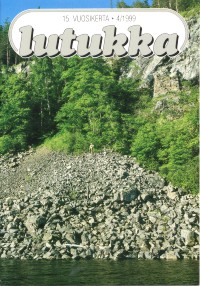 |
Tiivistelmät (englanniksi)
Hakila, R. 1999: Huonosti käyttäytyviä uhanalaiskasveja. – Lutukka 15(4):99–103.
Misbehaving threatened plants
Threatened plants usually grow in stable conditions, in natural conditions or traditionally treated. Occasionally they are found in man-made, chaotic habitats. This tendency is called anthropomorphical misbehaviour.
Examples of misbehaving plants are described from Satakunta, SW Finland, and from Pielavesi, Central Finland. A threefold case of misbehaviour is Lycopodiella inundata. At early 1900's, this plant of normally meso-eutrophic fens appeared on exposed beaches which were formed as a result of lake-drying mainly for agricultural purposes. Nowadays, this species is observed quite frequently on bottoms of abandoned gravel pits, paludified because of high ground water level.
Misbehaving plants constitute a problem for nature conservation. Their conservation status may not be favourable in the sense of European Union's habitat directive. However, because of random occurrences, the decline of natural populations is not easily recognized. Methods of protecting the chaotic structure of nature are considered. Rather than creating artificial habitats for species of certain environmental requirements, it is recommended that some abandoned man-made habitats are to develop naturally, without attempts to manipulate their vegetation.
Heikkilä, U. & Uotila, P. 1999: Retkeily Laatokalla 1997. – Lutukka 15(4):104–112.
An excursion to Lake Ladoga
The nature on the north shore of Lake Ladoga (Republic of Karelia, Russia) is exceptionally rich due to its variable climate, bedrock type and landscape, e.g. warm rock precipices, fertile valleys and narrow, fjord-like coves. Especially rock precipices, often facing south or southwest (riuttavuori mounts) form a very special environment with disjunct outposts of several rare species. The large Ladozhkie Skerries national park is under planning on the area. Up to the Second World War the area belonged to Finland, and much botanical and zoological information has been collected from this area to Finnish museums and archives. The goal of the project by the Finnish Museum of Natural History in collecting this old data of plants, lichens and some groups of insects, was to discover from the planned park all the 'hotspot' localities with a great number of threatened species. In 1997 a field excursion was made to the north shore and off-shore islands of Lake Ladoga to see how these localities were preserved. Descriptions of several localities visited during the excursion are presented in this article. More comprehensive results are given in Norrlinia vol. 7, 1999.
Räsänen, J. 1999: Satunnaiskasveja valtateiden 6 ja 17 pientareilla. – Lutukka 15(4):114–116.
Casual aliens along highways 6 and 17, E Finland
Casual aliens were inventoried in 1997 along the newly sown verges of highways 6 and 17 in North Karelia and North Savo, eastern Finland. The seed source seems to have been the same in all cases, with Agrostis castellana (given as A. capillaris on the label of the seed blend) and Lolium perenne as the main species. The most common casual aliens in the lawns were Anthemis cotula, Vulpia myuros and Senecio vernalis. They are all very rare in the area, and V. myuros new to the biogeographical province of North Savo. Other casuals included e.g. Papaver rhoeas and Holcus lanatus, the latter of which had earlier only been found in North Savo before 1951.
Jutila, H. & Jutila, K. 1999: Ulvilan Pappilanlammen luontoselvitys 1996. – Lutukka 15(4):117–125.
Nature survey of Pond Pappilanlampi during summer 1996
Pond Pappilanlampi is located in the municipality of Ulvila in the biogeographical province of Satakunta, W Finland. The bedrock here is sandstone, which is covered by thick layers of soil. The study area started to rise from the sea about 1 200 years ago, when Pappilanlampi was a part of the delta of River Kokemäenjoki. The pond is eutrophic and serves as a natural sedimentation basin. There are some previous studies on the flora, but not on the vegetation or fauna. The flora, vegetation and fauna of Pond Pappilanlampi were studied during three visits to the area in the summer of 1996. Aerial photographs and diving were also used.
Aquatic vegetation zones were narrow due to the fairly steep slopes. There were no isoetides and elodeids. Nuphar lutea dominated the nympheid zone. Rich helophyte vegetation was dominated by Phragmites australis, Typha latifolia and Iris pseudacorus. Filipendula ulmaria, Scolochloa festucacea, Salix phylicifolia, Carex aquatilis and Cicuta virosa were the most common shore plants. These were surrounded by forests and fields.
There were altogether 203 vascular plant species in the study area. Wetland plants were the most numerous, but also many hemerophilous plants were found. The rarest species in the study area were Bolboschoenus maritimus, Adoxa moschatellina, Scolochloa festucacea, Calystegia sepium, Carex diandra and Thelyptheris palustris. No endangered species were found. Bolboschoenus maritimus is mainly a seashore plant in Finland and it has not been found earlier in fresh water in Satakunta.
The nesting bird fauna was studied during two visits. Invertebrates were observed both on the shore and in the water. Flower stands, especially Filipendula ulmaria and Lythrum salicaria were found to be important for insects. Aquatic invertebrates were found mainly in the nympheid stands and in roots of helophytes.
Pond Pappilanlampi, its outlet and shores form a locally important entity with biodiversity values quite near the centre of the municipality. Most of the area should be let to develop naturally and the meadows should be managed.
Floristic notes – Lutukka 15(4):125–126
-
Hyoscyamus niger is reported from Pyhäselkä, E Central Finland near the NE margin of its distribution area in the country. Half a dozen plants had arisen from an old seed bank by a house wall. – J. Räsänen
-
A short-lived occurrence of Lythrum portula was found in a roadside ditch in Liperi, biogeographical province of North Karelia. There had formerly been only one uncertain record of the species from the province. – J. Räsänen
-
Herniaria glabra has been known from Pori town, W Finland, only in Reposaari, an old harbour area, where the plant has been introduced with ballast. In 1997 and 1999 Herniaria was found in the proper town area in three localities. It has probably grown in the area for decades already without being found. Also these stands have probably arisen from ballast, which was once trasported to the town area. – J. Lampolahti
-
Lemna trisulca was found in 1992 as a neophyte near Lappeenranta, in the SE Finnish biogeographical province of South Savo. The species has probably invaded from the Russian territory, where the nearest known localities are at ca. 40 km's distance. The occurrence is still missing in the 4th edition of the Field Flora of Finland (Hämet-Ahti et al. 1998). – K. Saarinen
Vuosikerran 14 sisältö (1998)
|
Numero 1/1998
Kasvihavaintoja
Kirjallisuutta
|
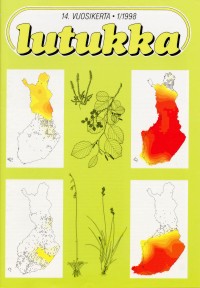 |
Tiivistelmät (englanniksi)
Lahti, T. & Lampinen, R. 1998: Neljästoista kesä: kasviatlas vuonna 1998. – Lutukka 14(1):3–11.
Atlas of the Distribution of Vascular Plants in Finland: the 14th Summer
The coverage of the Finnish national floristic database is, after 30 years of recording data from herbarium specimens, floristic papers and unpublished field notes, still very uneven as to different parts of the country, and to different plant taxa. The project 'Atlas of the Distribution of Vascular Plants in Finland', started in 1985, has turned into a continuous surveillance project for recording the distribution of Finnish plants, and for following changes in their occurrence. The results are published every few years as a digital database. The 10 km x 10 km distribution maps are complemented by estimations of the likelihood of occurrence. The likelihood estimates, shown as colour shades on the maps, are interpolated from data received from the detailed study on 1 km x 1 km squares.
The database coverage and the progress of the mapping project are described, and the importance of detailed inventories of 1 km x 1km squares, and the less complete species lists of the so far poorly covered areas, is emphasized by coincidence maps showing the total number of species and the numbers of the most common species, and by a map of the 10 km x 10 km squares with thoroughly studied 1 km x 1 km squares. Some wishes for improving the quality of field notes in order to make them usable also in other mapping projects are given.
Repeated inventories of 1 km x 1 km squares by different botanists during one season can be used for quantitatively estimating how easy it is to find a certain species or - when the inventories are made at longer intervals - for following changes in the flora. The authors encourage this kind of studies to be started. Apart from the floristic mapping, the authors present a scheme for collecting vegetation data from permanent relevés from all kinds of habitats, to be used for analysing the seasonal and long-term changes in the vegetation. The www services of the Botanical Museum of the Finnish Museum of Natural History are described briefly.
Vilpa, E. 1998: Yli neljännesvuosisata Oulun kasvistoryhmän maastotutkimuksia Pohjois-Suomessa. – Lutukka 14(1):12–14.
More than quarter of century of cooperation between the University of Oulu and a society of nature lovers in the floristic research of northern Finland
The Botanical Museum of the University of Oulu together with voluntary participants from the society Oulun Luonnonystäväin Yhdistys ('Nature Lovers of Oulu') have organized floristic field work in northern Finland since the early 1970s, when a special floristic team of the society was founded. In addition to more traditional inventories, this cooperation includes more detailed studies on the floras of especially valuable areas and of quadrats for the 'Atlas of the Distribution of Vascular Plants in Finland', and inventories and monitoring of threatened plants. Communication with authorities responsible for land use is an important part of the work, too. A new project to map accurately the past and present floras of the town of Oulu itself is in progress.
Ryttäri, T. 1998: Uhanalaisuus uusiksi. – Lutukka 14(1):15–23.
New Finnish Red Data Book in preparation
Red Listing is an important tool for conservation of species, habitats and areas. The preparation of the third version of Finnish Red Data Book started in June 1997. The aims of the work are to compile revised lists of nationally and regionally threatened species in Finland, to evaluate which species are in need of special protection, and to compile a list of those species for the protection of which Finland has an international responsibility. The new categories and criteria accepted by the IUCN Species Survival Commission are applied in the ongoing process. However, some national modifications have been made. The structure of the categories, main features of the criteria and the process itself are presented. The usability of the criteria in the categorisation of vascular plants is discussed. An appeal is made to both amateur and professional botanists for commenting the preliminary national list and for gathering and submitting information especially on the taxa listed.
Piirainen, M. 1998: Meriratamo maantiekasvina. – Lutukka 14(1):24–27
Plantago maritima as a roadside plant in Finland
Plantago maritima is reported as a roadside plant from 11 separate areas in Finland. The species has been regarded as an obligatory halophyte (i.e. seashore plant) in the country. The first Finnish roadside record is probably from 1960 from Turku in the southwest, though based on a somewhat dubious pupil specimen. From 1985 onwards, and especially in the 1990s, the species has been recorded in roadsides so far in six biogeographical provinces. The author found the plant at eight sites close to each other along two main roads W of Helsinki (province of Uusimaa) and at five sites along the main road from Hanko to Hyvinkää (provinces of Varsinais-Suomi and Uusimaa) in 1997. The use of salt in controlling winter-time slippery conditions of the roads is probably a precondition for roadside populations of the species.
Kääntönen, M. 1998: Harvinainen puisto- ja korpinurmikan risteymä (Poa x pawlowskii) Tampereella. – Lutukka 14(1):29–21.
Poa chaixii x remota found in Finland
At Haihara manor in Tampere, S Finland, foreign grass seed was used for the lawn as was common in Finnish parks in the late 19th century. With this lawn seed plants like Luzula luzuloides and Poa chaixii invaded. The oozing ground water of the park area enabled Poa remota to spread from the surrounding native vegetation. The hybrids found in 1996 are various intermediates between Poa chaixii and P. remota. As the parents seldom grow side by side, the hybrid is rare and may be known from the former Czechoslovakia only.
|
Numero 2/1998
Kasvihavaintoja
|
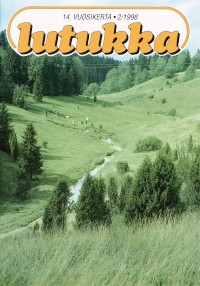 |
Tiivistelmät (englanniksi)
Pykälä, J. 1998: Onko Suomessa sata vai kaksisataa muinaistulokaskasvia? – Lutukka 14(2):5–57.
100 or 200 archaeophytes in the flora of Finland?
During the recent decades, the number of archaeophytic plants in Finland has been doubled as many plants considered native earlier are now believed to be archaeophytes. Suominen & Hämet-Ahti (1993) reported 192 species (228 taxa) as archaeophytes in Finland. In my article the problems and methods of discernment between native plants and archaeophytes are discussed.
Recently, the importance and extensiveness of man's impact on the flora of Finland have been emphasized more and more. Most of the land in southern Finland was influenced by slash-and-burn culture, cattle grazing and/or mowing during the period ca. (1600-)1700-1900(-1950). Consequently, the vegetation and flora experienced great changes. It is possible that alien plants have spread widely to native vegetation, and in many cases traces of introduction have become obscure as time passed on.
However, I suggest that the number of archaeophytes in the flora of Finland is overestimated today. It is probable that many native plants have lost all or most of their original sites and, because of that, are now growing exclusively or mainly in human-influenced habitats. In southern Finland more than half of many habitats (e.g. rich fens, several kinds of flooded areas, springs, rich herb forests, naturally eutrophic lakes) have been destroyed by man.
Palaeoecological data suggest that many southern plants - some of them considered archaeophytes now - existed in Finland already ca. 5 000-10 000 years ago. The possibilities for southern flora to survive in Finland after the deterioration of the climate and the invasion of Norway spruce have been underestimated, because the great importance of natural disturbances in boreal ecosystems has not been realized. In fact, fires, storms, floods, beavers and other natural factors causing such disturbances are probably crucial for the existence of many southern plants. Man has efficiently suppressed these disturbances, which has led to the apparently mistaken idea that almost all disturbance-dependent plants are aliens. Grazing, mowing and slash-and-burn agriculture helped many of the disturbance-dependent plants to survive in a landscape with fewer natural disturbances and increased the abundance of both archaeophytes and many southern natives (apophytes).
The rise of calcareous areas of Åland and other parts of the southwestern archipelago from the Baltic Sea during the recent millennia has made it possible for new calcicole and calciphilous plants to immigrate to Finland, probably mostly from Estonia. As these areas have been -- at least partly -- under human influence from the very beginning, it is difficult to judge whether these immigrants should be classified as natives or archaeophytes.
Native status is possible for at least half (123 taxa) of the plants considered archaeophytes now (Table 3). Less than 100 species are certainly (or almost so) archaeophytes. Native or archaeophytic status of some plants is discussed in detail. Alchemilla glaucescens (calcareous rocks), Campanula cervicaria (forest fire areas, openings in rich herb forests), Carex ovalis (openings in rich herb forests, forest fire areas), Cerastium fontanum subsp. vulgare (seashore rocks, calcareous and ultramafic rocks), Chelidonium majus (rocks and boulders in rich herb forests), Crepis praemorsa (esker forests), Erigeron acer subsp. acer (calcareous rocks), Euphrasia rostkoviana subsp. fennica (calcareous rocks), Hypericum maculatum (rich herb forests), Luzula multiflora subsp. multiflora (forest fire areas, openings in forests), Pimpinella saxifraga (rock outcrops, openings in dry rich herb forests), Persicaria lapathifolia subsp. lapathifolia (sea and lake shores), Potentilla neumanniana (calcareous rocks) and Rumex longifolius (seashores) are probably native in Finland. Androsace septentrionalis is probably a native esker plant in Lammi, inland S Finland, but may be elsewhere an archaeophyte or, more often, a neophyte. Chenopodium polyspermum (river and lake shores), Elatine alsinastrum (river and lake shores), Isatis tinctoria (seashores) and Plantago lanceolata (calcareous rocks) may be as well natives as archaeophytes.
It is suggested that the probable number of archaeophytes in the flora of Finland is between 100-140 species (120–170 taxa). However, the status of many plants remains obscure. Ecological and palaeoecological studies are needed for a more accurate discernment between native plants and archaeophytes.
Kaakinen, K. 1998: Tummaraunioinen löytyi uudelleen Rovaniemen läheltä (PeP). – Lutukka 14(2):58–59
The northernmost Finnish population of Asplenium trichomanes refound
Asplenium trichomanes was collected in the rural commune of Rovaniemi, northern Finland, in 1923. Since then the population remained unfound for many decades and was therefore considered extinct. However, in 1992 it turned up in a cave-like rock crevice of a hill belonging to the quartzite massif of Louevaara in the village of Muurola. The locality is the northernmost for the species in Finland and quite disjunct from the nearest ones in Central Finland and in northern Scandinavia.
Lahtonen, T. 1998: Punaimikkä (Pulmonaria rubra) Orivedellä (EH). – Lutukka 14(2):60–61.
Pulmonaria rubra in Orivesi, Central Finland
Pulmonaria rubra Schott is a native of SE Europe. It was found established and spreading in Orivesi at the Hörtsänä arboretum on a rich, moist slope with Norway spruce forest. The arboretum has been neglected for over 50 years, and it hosts a number of other escapes native of Central European and North American woods.
|
Numero 3/1998
Kasvihavaintoja
|
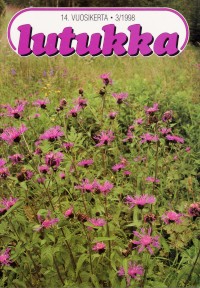 |
Tiivistelmät (englanniksi)
Kontula, T. & Kotiluoto, R. 1998: Lounainen rannikkorahkasammal (Sphagnum imbricatum) Suomessa. – Lutukka 14(3):67–71.
Sphagnum imbricatum, a southwestern rarity in Finland
Sphagnum imbricatum has been found in Finland only in thirteen localities, all of them in the southwest, in 1884-1981. In eight of the localities the species was still present in 1994, when also a new locality was discovered in the extreme southwestern archipelago. The Finnish habitats of the moss are such mire site types and lake shore banks which are quite common in southern Finland. Thus, the rarity of the species is not due to the lack of suitable habitats, but is best explained by its oceanic character. On the other hand, the identification of S. imbricatum in the field is difficult, which may have caused some underrating of the distribution, although extensive sample plot materials from Finnish mires have proved that the species is truly rare. It is classified as a nationally vulnerable species in Finland. Some of its localities are already included in nature conservation areas, and the protection of all the localities is recommended.
Kääntönen, M. 1998: Tähkämaitikka (Melampyrum cristatum) – Keski-Hämeen viljelyseudun erikoisuus. – Lutukka 14(3):74–79.
Melampyrum cristatum at its exclave in S Finnish inland
In the interior of S Finland Melampyrum cristatum is an archaeophyte restricted to the core of Iron Age agricultural landscape of the biogeographical province of South-Häme. Old and partly inexact or unreliable records exist from a somewhat larger area, but all five present occurrences known lie in Sääksmäki, town of Valkeakoski. The sites are old grazed grasslands characterized by Trifolium medium (obvious host of M. cristatum) and several Iron Age archaeophytes. Nowadays these grasslands are threatened by overgrowing shrubs and tall herbs, and the only way to preserve M. cristatum is a conscious continuation of grazing and mowing. Fortunately, the land-owners have a positive attitude towards this rare plant.
Saarinen, K. 1998: Lappeenrannan hierakkatulokkaiden kuulumisia: isohierakka vakiintunut, keltahierakka taas nousussa. – Lutukka 14(3):88–91.
The present status of Rumex hydrolapathum and R. maritimus in Lappeenranta, SE Finland
Rumex hydrolapathum was found in 1987 as an alien in crevices of the stony banks of the Saimaa Canal. The species, probably immigrated fairly recently with cargo vessels from the Gulf of Finland, is nowadays well established in the habitat. In the 1990s the range of the species has expanded despite of the reconstruction of some stony banks of the canal. Rumex maritimus, also an alien in the region, was first detected in 1988 on the bottom of a former liquid waste basin of a sulphite cellulose factory. The drying of the basin resulted in an almost complete disappearence of the species in the early 1990s, but in 1998 almost one thousand individuals were found again. The origin of the species in the site is obscure, but it was probably introduced by waterfowl or birdwatchers. It is evident that both these Rumex-species have permanent populations nowadays in the biogeographical province of South Savo.
|
Numero 4/1998
|
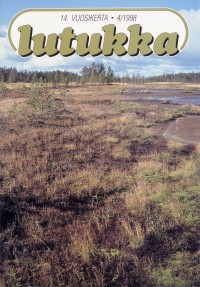 |
Tiivistelmät (englanniksi)
Ulvinen, T. & Varkki, A. 1998: Uusia tietoja Pohjois-Suomen kasvistosta 1. Alkuperäiskasveja. – Lutukka 14(4):99–114.
New records for the northern Finnish flora
The paper summarizes new records of 42 indigenous vascular plant taxa from northern Finland (biogeographical provinces Kainuu / Kn, Oulun Pohjanmaa / OP, Perä-Pohjanmaa / PeP, Koillismaa / Ks, Kittilän Lappi / KiL and Sompion Lappi / SoL). These include Diphasiastrum × zeilleri (Keski-Pohjanmaa, Kn, OP, PeP, Ks), Dryopteris cristata (OP), Polystichum lonchitis (PeP), Nymphaea tetragona (Ks), Ranunculus peltatus ssp. baudotii (OP), Ranunculus confervoides (Kn), Cerastium alpinum ssp. glabratum (Ks), Sagina saginoides (SoL), Atriplex longipes ssp. longipes (OP), Persicaria foliosa × lapathifolia (PeP), Monotropa hypopitys (OP), Valeriana sambucifolia ssp. salina (OP, PeP), Lonicera caerulea (PeP), Callitriche hamulata (Ks), Pedicularis palustris ssp. palustris (KiL), Pinguicula alpina (KiL), Pilosella peleteriana (KiL, not PeP), Juncus balticus × filiformis (KiL), Dactylorhiza incarnata ssp. cruenta (Ks, SoL), and Carex arctogena (KiL). The distribution of Utricularia ochroleuca and U. stygia in northern Finland is reviewed. A few species, which were considered earlier as immigrants or garden escapes in the province, have evidence of indigenous occurrence, viz. Atriplex longipes ssp. praecox (OP), Sedum telephium ssp. maximum (OP), and Rosa acicularis (OP). Further four species, which were considered as extinct from the province, have been refound, viz. Impatiens noli-tangere (Kn), Gentiana nivalis (PeP), Gymnadenia conopsea (OP), and Carex rotundata (Kn). Two species have disappeared, Thelypteris palustris from the province PeP and Elymus alaskanus ssp. scandicus from KiL. Some corrections are made, too. Ranunculus aquatilis var. diffusus has not been found in Kn and Ks, Stellaria palustris not in SoL and Inarin Lappi, Sagina nodosa not in Kn, Spergularia salina not in PeP, Saxifraga rivularis not in KiL, Carex lapponica not in Ks, C. panicea not in SoL and C. norvegica ssp. norvegica not in OP.
Väre, H., Ohenoja, M. & Halonen, P. 1998: Ruusujuuri ja muuta mukavaa Pudasjärven Ruskeakalliolla. – Lutukka 14(4):115–118.
An isolated locality of Rhodiola rosea found in N Finland
One individual of Rhodiola rosea was found in 1994 on a terrace of a remote riverside rock precipice in Pudasjärvi, NE of the town Oulu. The distance from the nearest known occurrences is more than 300 km. The plant is presumably a relict from early postglacial time. The rock is fairly dry and acidic. Associated mosses and lichens include, however, a number of rare species, even some calciphilous ones.
Suominen, J. 1998: Jaakko Sarvela Etelä-Pohjanmaan kasviston tutkijana. – Lutukka 14(4):119–126.
Jaakko Sarvela and his floristic studies in Etelä-Pohjanmaa (South Ostrobothnia), W Finland
Jaakko Sarvela (1914–1996) was an amateur botanist interested in many critical plant groups. Special objects of his studies were the Pteridophytes, particularly Dryopteris and Gymnocarpium worldwide. His other interests included ethnology, linguistics and genealogy as well as the dialect and place names of his birth province Etelä-Pohjanmaa.
In his youth Jaakko Sarvela published (1937) floristic finds from his native district. Then, during many decades, he gathered a rich and reliable material from there. Unfortunately, it was never published. This article describes briefly Sarvela's study area and his floristic material as seen against the background of the whole province of Etelä-Pohjanmaa.
Vuosikerran 13 sisäöltö (1997)
|
Numero 1/1997
Kasvihavaintoja
|
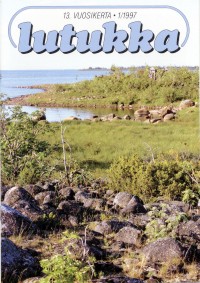 |
Tiivistelmät (englanniksi)
Nummela-Salo, U. & Salo, P. 1997: Perämeren kansallispuiston kasvistosta ja kasvillisuudesta. – Lutukka 13(1):3–15.
Flora and vegetation of the Perämeri National Park
The Perämeri National Park is situated in the outer archipelagos of the towns of Kemi and Tornio in the northern part of the Gulf of Bothnia (in Finnish 'Perämeri') and thus represents the northernmost island nature of the Baltic Sea. The park belongs to the middle boreal vegetation zone of northern Europe. The total area of the park is c. 157 km2, of which only c. 2,5 km2 is land. It consists of 36 open-sea moraine islands of varying developmental stages of isostatic adjustment: boulder skerries, grassy skerries, grassy islands, wooded islands and islets. The islands are low (average height not more than c. 4,5 m) and surrounded by shallow open sea. The salinity of the surface water is less than 3 ‰ in the summer, and in the northern parts of the park the water is at times almost fresh due to floodwaters of the large rivers Tornionjoki and Kemijoki. Shore meadows, boulder beds reaching the sea, juniper heaths, and dry meadows around tradional fishing villages are the most characteristic habitats of the park. Tops of the islands are always boulder-strewn barrens. The top of the largest island called Iso-Huituri is surmounted by a huge cairn known as Piispankivi ('Bishop's Stone'). In the Middle Ages it marked the divide between the dioceses of Finnish Turku and Swedish Uppsala.
In the Perämeri area the annual rate of land uplift is c. 9 mm, i.e. more than elsewhere in and around the Baltic Sea. Consequently, nature in the area is continuously and relatively rapidly changing. New islets emerge from the sea, expand and join each other. At the same time vegetation belts around the islands are moving and replacing each other. However, plant communities of similar habitats at the same height above the sea level remain fairly similar. The numbers and widths of different successional belts are mainly dependent on the topography and degree of exposure of the shore.
About 240 taxa of vascular plants are known from the Perämeri National Park. Four of them are endemic to the Baltic area: Alisma wahlenbergii, Artemisia campestris subsp. bottnica, Euphrasia bottnica, and Deschampsia bottnica. Ten of the taxa (seem to) belong to the so-called Primula sibirica group, the members of which are confined to shores of the Baltic Sea and the White Sea. The vascular flora includes six nationally threatened taxa and 14 taxa which have been classified as threatened in the southern part of the province of Lapland. In addition, two nationally threatened fungi and one regionally threatened moss have been found in the park.
Ryttäri, T. 1997: Arto ja kahdeksan botanistinaista Saarenmaalla. – Lutukka 13(1):17–26.
Botanical excursion to Saaremaa Island, Estonia
As part of the cooperation of the Ministries of Environment of Estonia and Finland, a joint four-day excursion of botanists from both countries was made to Saaremaa Island in westernmost Estonia in mid-June of 1996. The main aims of the excursion were to acquaint the Finnish participans with protection, management and monitoring of rare and threatened plants in Estonia and with the nature of Saaremaa as a whole, and to compare and unify research and monitoring methods. The excursion was preceded by a seminar on the same topics held in Finland in the previous spring.
The plants intensively monitored in Saaremaa Island and in the adjacent Muhu Island include many orchids, for example Cypripedium calceolus, Cephalanthera longifolia, C. rubra, Anacamptis pyramidalis and Orchis morio, as well as various other species (Hypericum montanum, Vicia lathyroides, Pinguicula alpina, Rhinanthus rumelicus subsp. oesilensis etc.). In addition to more traditional methods, for instance modern isoenzyme techniques are used in the monitoring to separate clones from each other. It is most desirable that the highly important monitoring work would continue at the full capacity in spite of the limited economic resources and present and future organizational changes in the country. To interrupt the long-term and admirably careful work, or even parts of it, would be a great loss to efforts towards understanding the population biology of plants, the only sound basis for their protection and management.
The nature of Saaremaa is exceptionally rich, diverse and fascinating. The Viidumäe Nature Reserve, founded in 1957, in the western half of the island is a representative example: there are more than 660 vascular plant species, of which 57 are protected in Estonia because of their rarity, in an area of 1 873 hectares. The habitat spectrum of Viidumäe is remarkably wide, ranging from rich spring-fens, luxurious herb-rich forests and beautiful wooded meadows to open pine forests with alvar-like patches. Also many other both floristically and scenically impressive localities of western Saaremaa were visited, examples of them and their plants being Odalätsi (large springs with a swift brook; Berula erecta, Carex paniculata), the region of Tagamõisa peninsula (beach, herb-rich and pine forests; Viola tricolor subsp. curtisii, Taxus baccata, Cephalanthera rubra), Vesiku (mire and seashore vegetation; Schoenus nigricans, Tetragonolobus maritimus), Sõrve peninsula (seashores of various kinds; Lõo alvar with Artemisia rupestris, Asplenium ruta-muraria, Hornungia petraea; Läätsa dunes with Dianthus arenarius subsp. arenarius, Koeleria glauca, Alyssum montanum subsp. gmelinii), and an open oak forest near Kuressaare (Orchis ustulata, Carex hartmanii). All over the island the amazingly rich and abundant orchid flora impressed greatly the Finnish participants. On the way back to Tallin, the Laelatu wooded meadows in the westernmost continent were visited (Serratula tinctoria, Pimpinella major etc.). Studies on the management and ecology of wooded meadows are carried out in Laelatu; also there are permanent plots for the monitoring of rare plants.
Many plant taxa are on the edge of their ranges or have marked outposts in Saaremaa. In fact, the island is a meeting place of plants having their main range in the north (e.g. Pinguicula alpina), in the east (e.g. Artemisia rupestris, Astragalus danicus, Oxytropis pilosa, Seseli libanotis subsp. intermedia), in the west (e.g. Sorbus rupicola) and, especially, in the south (e.g. Alyssum montanum subsp. gmelinii, Anacamptis pyramidalis, Berula erecta, Carex davalliana, Cladium mariscus, Eryngium maritimum, Festuca altissima, Gymnadenia odoratissima, Hedera helix, Hornungia petraea, Juncus subnodulosus, Koeleria glauca, Scabiosa columbaria, Schoenus nigricans, Taxus baccata, Tetragonolobus maritimus, Teucrium scordium, Tofieldia calyculata, Trifolium alpestre, Viola pumila). Rhinanthus rumelicus subsp. oesilensis (R. oesilensis) is endemic to Saaremaa, and Dianthus arenarius subsp. arenarius is restricted to the Baltic republics and southern Sweden.
Auvinen, P. & Simola, H. 1997: Kieretin Karjalan kiehtova kasvimaailma. – Lutukka 13(1):27–21.
Excursion to the White Sea
Botanical impressions from a 10-day excursion to the western coast of the White Sea and to Solovetsk Island in summer 1995 are presented. The sites visited (in the biogeographical provinces of Karelia pomorica occidentalis and Karelia keretina) included Belomorsk, Chupa, Kartesh Biological Station, villages Sonostrov and Keret, and Solovetsk. Among the vascular plants observed there are species which are absent (Conioselinum tataricum, Cotoneaster cinnabarinus, Mertensia maritima) or are more or less rare in Finland (e.g. Cochlearia officinalis, Ligusticum scoticum, Saxifraga cespitosa, Veratrum album).
|
Numero 2/1997
Kasvihavaintoja
Kirjallisuutta
|
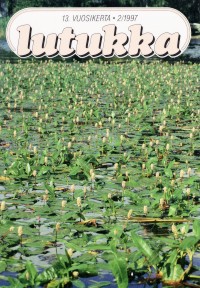 |
Tiivistelmät (englanniksi)
Uotila, P. 1997: Hattulan Lehijärvi - vesikasvijärviemme parhaimmistoa. – Lutukka 13(2):35–50.
Aquatic macrophytes of the Lake Lehijärvi, southern Finland
Lake Lehijärvi is situated in the municipality of Hattula, close to the town of Hämeenlinna. The bedrock around the lake is partly uralite porphyrite, and in the lake there are some springs especially in front of the esker on the eastern shore. The catchment area consists largely of arable land, and the shores of the lake have been intensively inhabited for hundreds of years. The lake is already naturally eutrophic, and probably auxotrophic at the beginning of this century due to lowering of the water level by approximately one meter. However, during the last few decades the lake has become fairly heavily polluted due to some sewage outflows from Hämeenlinna, from numerous summer cottages and permanent houses along the shore without ordinary waste water treatment systems, and because of the intensive agriculture in the catchment area. Due to the pollution, nutrient levels have been high, occasional oxygen deficiencies exist, and every summer heavy blue green algae blooming is a common phenomenon. The flora of the lake was inventoried for the first time by Prof. Kaarlo Linkola in 1932. Since then the flora has been studied by using canoes in 1973, and again, but less completely, in 1982 and 1996. In addition to these inventories, herbarium specimens have been collected sporadically from the lake since 1859.
Forty-five aquatic plant species have been reported from the lake. This is somewhat lower than in the most species-rich lakes in Finland (e.g. Lake Vesijärvi, Lake Siikalahti, Lake Lepinjärvi) and the nearest large lake Vanajavesi (51 species; Uotila 1971). At present, the greatest rarities in Lake Lehijärvi are Ranunculus confervoides, Zannichellia palustris subsp. repens, Potamogeton pusillus, P. lucens, Stratiotes aloides and Chara braunii. However, the flora has not been very stable and has changed greatly during this century. Sparganium gramineum and Riccia fluitans were found only in the first study of 1932. Potamogeton obtusifolius was noted for the first time in 1973 and Zannichellia palustris, Ceratophyllum demersumand, Elodea canadensis in 1982. The first discoveries of Spirodela polyrhiza date from 1996. Changes in the frequency and especially abundance have also been marked. Ranunculus peltatus, Myriophyllum alterniflorum and Potamogeton gramineus have greatly diminished, and Elodea canadensis, Ceratophyllum demersum and Potamogeton obtusifolius particularly have increased to massive concentrations in the lake. Even P. lucens and P. praelongus may have increased. Of isoetids and little elodeids the earlier predominant taxa, such as Subularia aquatica, Ranunculus reptans and Eleocharis acicularis seem to have decreased (Subularia is possibly absent at present), Elatine hydropiper perhaps first increased and now decreased, and Ranunculus confervoides and Zannichellia palustris have both increased.
The main direct and indirect reasons for changes is increased eutrophy of the lake. That allowed the massive increase of invasive Ceratophyllum, Elodea and Zannichellia, and caused drastic changes in competitive ability for small isoetids and many elodeids. Reduction of pasture land has affected decrease of plants in open water patches near the shore. Arrival to the lake by muskrat (Ondantra zibethica) has caused decreases at least for Nymphaea alba subsp. candida, and perhaps increases for Typha latifolia.
Piirainen, M., Often, A. & Alm, T. 1997: Sammakonleinikki ja muita jätelietekuoppien kasveja Petsamossa 1995–1996. – Lutukka 13(2):51–54.
Ranunculus reptabundus and other species in sludge basins in Pechenga, Russia, in 1995–1996
The Pechenga area, which belonged to Finland in 1920–1944, has largely been closed to western foreigners after the Second World War. Since ca. 1990, the area has opened up to foreign visitors, though many military restrictions are still in force. During 1995 and 1996, we studied the vascular flora in various cultural habitats in Pechenga (e.g. several wartime German army sites, a post-war power station, former farm areas, and recent Russian villages and waste grounds).
The sewage waters of several settlements are simply led into open pits. A number of nitrophilous species flourish in these sludge basins. The flora of three such habitats is briefly described: 1) The site of a former collective farm at Salmijärvi, between Salmijärvi and Kuotsjärvi lakes (69° 24' N, 30° 04' E), where dung was previously discharged into a swampy depression adjacent to the road to Nikel; 2) The western bank of the Kolosjoki river in Nikel, where a sewage sludge pool has formed next to a military camp (69° 24' N, 30° 12' E); 3) Kirpitsnyj zavod, a military check-point in the Pasvik valley, ca. 13 km SWW of Nikel town (69° 22' N, 29° 54' E), where latrines have been emptied in heaps on a slope above the valley of a small brook, producing a sludge area on the lower slope.
Rumex aquaticus flourished at all these sites, and Catabrosa aquatica was abundant at Kolosjoki and Kirpitsnyj zavod. The most interesting plant was Ranunculus reptabundus, which formed a tangled, pale green carpet over the sludge at Salmijärvi and Kolosjoki. The mainly Northeast European species R. reptabundus is close to R. sceleratus (syn. R. sceleratus subsp. reptabundus). It grows also in a limited area in northern parts of central Finland. Along the White Sea coasts it is native on moist shore meadows and in shallow pools. From the Murmansk Oblast, it has previously been recorded as a casual only in the Chibiny area and Jokanga.
Juncus compressus was found on the sludge at Kirpitsnyj zavod. As far as we know, this is the first record from northern Fennoscandia (N Norway, N Sweden, N Finland and the Murmansk Oblast). Ribes nigrum was also found growing in the Kolosjoki sludge pools. Elsewhere in Pechenga, we have only seen it as a cultivated species or persisting after cultivation, though it may be native at some stations along the Pasvik river. Other species recorded on the sludge include Ranunculus hyperboreus, Stellaria crassifolia, Triglochin palustris, Poa trivialis and Agrostis gigantea.
Several interesting species were growing on the waste grounds surrounding the sludge pools. Symphytum officinale was found at Salmijärvi. It is a rare ornamental in the Murmansk Oblast, and has earlier been recorded from outside gardens there only in one locality (Kovda). Rubus idaeus, which has escaped from cultivation in a few localities in the Pechenga area, was found at Kolosjoki. Taxa of eastern origin include Rumex confertus (Kolosjoki), R. pseudonatronatus, Bromus inermis (Kolosjoki and Kirpitsnyj zavod), Bunias orientalis, and Heracleum sphondylium subsp. sibiricum (Kirpitsnyj zavod). Myosotis nemorosa was found as a supposed wartime German alien at Kirpitsnyj zavod. Trifolium montanum at the same locality may be either of wartime German or postwar Russian origin.
Water samples from all the three sludge basins were analysed with respect to the main nutrients. Their concentrations corresponded to those in undiluted sewage. The conductivity was high at all the three sites. The particularly high figure for Salmijärvi seems to be associated with the high chloride contents. The Salmijärvi sample also had a very high total nitrogen value, about twice to three times the normal figure for undiluted sewage. The nutrient level at the two other sites was clearly lower. In terms of dealing with the sewage problem, these "open-air sewage treatment plants" are probably ineffective; their only function is to slow down the flow of the nutrients. Controlled outlet of sewage e.g. through an oligotrophic mire would probably improve the situation somewhat.
Kurtto, A. & Helynranta, L. 1997: Helsingin kasveja 2. Erään "kansallisnäkymän" kasvisto. – Lutukka 13(2):55–57.
Plants of Helsinki 2. Flora of a "national scene"
The Lutheran Cathedral of Helsinki, seen from the south and thus including the imposing south-facing stone steps, is one of the most popular subjects in postcards bought by tourists visiting the city and in photographs and videotapes taken by them, as well as in TV programs presenting Helsinki and the whole of Finland. Thus, the church with its steps can justifiably be regarded as one of the "national scenes" of Finland. To reach the main entrance of the church from the south, i.e. from the Senate Square, one has to climb almost 50 steps. The total length of the narrow (on the average c. 2 cm) horizontal and vertical crevices between their stones is c. 4 km. Altogether 74 vascular plant species were found growing in the crevices on the 30th of June, 1996. About three-quarters of the species were scanty or very scanty. The most abundant plants were Sagina procumbens, Chaenorhinum minus and Plantago major. Of the mosses, Bryum argenteum, Funaria hygrometrica, Ceratodon purpureus and Pohlia nutans were the most successful ones.
Plants have three main means of reaching the steps. About one third of the species found are predominantly anemochorous. Dispersal by wind is possible even from the nature surrounding the city. Many species have arrived as diaspores adhering or clinging to footwear, clothes or dogs by means of slimy or tuberculate surfaces, or by hooks or spines. A special group of the flora consists of food plants, among them some exotic ones. People come to the steps to eat fruits bought from the nearby market square and leave unedible parts, including diaspores, of their provisions around their sitting places.
Räsänen, J. 1997: "Varjonata" (Festuca heterophylla) Joensuussa (PK). – Lutukka 13(2):62–63.
The first find of Festuca heterophylla in Finland
Festuca heterophylla and F. nigrescens were found in Joensuu, eastern Finland, as casual lawn seed immigrants in 1995 and 1996. The former species has not been recorded in Finland earlier, and the latter is new to the biogeographical province of Pohjois-Karjala (North Karelia). Vulpia myuros, Bromus tectorum and B. hordeaceus were found on the same lawn in 1994.
|
Numero 3/1997
|
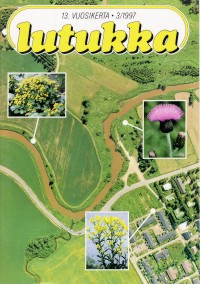 |
Tiivistelmät (englanniksi)
Ranta, P., Tanskanen, A. & Siitonen, M. 1997: Vantaan kasvit: kaupunkiekologia, monimuotoisuus ja suojelu. – Lutukka 13(3):67–87.
Vascular plants of the City of Vantaa, S Finland - urban ecology, biodiversity and conservation
The flora of the City of Vantaa was systematically mapped in 1990–95. The City was divided in 246 quadrats of 1 km2. The collected material consists of 53 072 observations of 704 species. During the mapping the frequency, abundance and habitats of each species were noted. All the material was stored in a database and was used later for studies on urban ecology. Nearly 70% of the observations are of native species. However, in densely built areas only about 50% of the species of each quadrat are native. The percentage of native species is highest (75-85%) in uninhabited forest areas. The western part of Vantaa is richer in species than the eastern part. Most of the species of rich deciduous forests are in the western part. There is also considerable variation in distribution patterns. Some species follow closely the river corridors, others occur in agricultural areas etc. In relation with urban areas, groups of urbanophilous and urbanophobic species can be distinguished. The number of quadrats required to represent all the 704 species is 64 (26% of total). In urban land use planning there are normally several conflicting interests. Biodiversity conservation has not been comparable with other, more easily measurable land use interests. The floristic material of Vantaa was used to develop a conservation value index to be able to compare different areas according to their conservation value. With the help of the method, an ideal nature reserve network was created and existing network tested. The 25 best quadrats represent 94% of all native species and archaeophytes. The ideal and the existing network (43 areas reserved for conservation) overlap partly, especially among the best areas. The existing network covers 68% of all the species in Vantaa. Of the 43 areas, only 10 best areas bring 94% of the species represented in the network and 18 areas make no contribution at all to the network. The areas included in the existing network of reserves have also other values and functions than conservation of plant biodiversity, but the use of reserve selection algorithms for network design may clearly produce more effective and biologically meaningful nature reserves than previously used methods. The mapping of quadrats will be combined with mapping of urban habitats according to their existing boundaries. Each habitat patch may be given a conservation value index. With the use of GIS-programs, the information on urban biodiversity will be accessible for all that make decisions on land use and management. The consequences on biodiversity can be readily seen on computer screens. Consequently, the method is regarded as an essential tool in urban biodiversity conservation and it has been adopted as an official policy in the future development of the City of Vantaa.
Hinneri, S. 1997: Käärmeenlaukan (Allium scorodoprasum) historiasta lounaissaaristossa. – Lutukka 13(3):88–95.
History of Giant garlic (Allium scorodoprasum) in the southwestern archipelago of Finland
The present occurrences of Giant garlic (Allium scorodoprasum L.) in the southwestern archipelago of Finland are cultivation relic populations and closeby populations derived from them by short-distance dispersal. The permanent settlement of the study area originates from the 12th century, i.e. from the Viking Age. At that time two important ship routes passed through the archipelago: one from Sweden eastwards to Russia, the other northwards to western Finland. Giant garlic is often growing in and around harbours, signal fires or seafarers' chapels along these ancient routes. Owing to the Quaternary land upheaval, the localities of the plant lie several meters above the sea level. Apparently Giant garlic was a scurvy herb for seafarers. Old, frequently rich populations of the species are growing around churches or in gardens of parsonages, which refers to a status as a sacred or cult plant. Perhaps as such and at least as a medicinal, spice and an ornamental plant this garlic was then transplanted to gardens of common archipelago people. The last plantations were made in the 19th century when many of fishermen's houses were built, but nowadays the usage is totally forgotten. So, the species is commonly found in old and often abandoned gardens of farm and fisherman houses, but sometimes also on remote rocky islets used as temporary bases for fishing. Many localities are uninhabited islands used for haymaking or pasturing of cattle. There were simple cottages only for passing nights. When Giant garlic is growing in shore forests rich in black alders and ashes, it is apparently a late colonist originating from a nearby village. Judging from solitary plants detected on seaside drift walls, bulbils of Giant garlic are able to float with reed stalks and other organic material. The amount and size of populations of Giant garlic are on the increase especially at open anthropogenic sites in villages and along roadsides. The rising temperature of growing seasons observed since the late 1970s may be one reason for the increase.
|
Numero 4/1997
Kasvihavaintoja
|
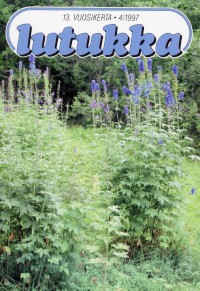 |
Tiivistelmät (englanniksi)
Särkkä, J. & Ulvinen, T. 1997: Kasvihavaintoja Raahen seudulta ja muualtakin Oulun läänin Keski-Pohjanmaalta. – Lutukka 13(4):99–115
New plant records from the northern part of the biogeographical province of Keski-Pohjanmaa (KP), western Finland
The paper gives information on new records of 14 indigenous vascular plant taxa in the northern part (Oulu administrative area) of the biogeographical province of Keski-Pohjanmaa, mostly in the area around Raahe town. This floristic element includes Atriplex longipes subsp. longipes, Circaea alpina, Corydalis solida, Pinguicula vulgaris, Ranunculus reptabundus, R. ficaria subsp. bulbilifer, Stellaria fennica and Viola selkirkii. The histories of Corydalis solida and Ranunculus ficaria in the area are somewhat dubious, and evidence of anthropochorous immigration does not exist. In the group of old immigrants, the most interesting plant is Alchemilla heptagona, which has been collected earlier in Finland only in the biogeographical province of Kainuu as a polemochore. Avenula pubescens has proved to be an archaeophyte in the area. Several German polemochores have been collected earlier in the Lapaluoto harbour area in Raahe. E.g. Carex disticha, Phyteuma orbiculare and Primula elatior are reported as new to the locality. In recent years the area has strongly changed due to building activities, but several polemochores have been transferred into a garden and will be planted in a special area in the harbour. The paper also summarizes records of 28 aliens, some of which are new to the biogeographical province (for example Datura stramonium, Epilobium roseum, Eruca vesicaria, Silene conoidea and Xanthium strumarium).
Kosonen, L. 1997: Lehtoukonhattu vakiintuneena Hämeenkyrössä (St). – Lutukka 13(4):116–117.
Aconitum lycoctonum naturalized in Hämeenkyrö, southwestern Finland
Since 1932 Aconitum lycoctonum (syn. A. septentrionale) has been known as naturalized on Isosaari Island in Kyrösjärvi Lake in Hämeenkyrö, SW Finland. The habitat is a herb-rich slope forest dominated by Norway spruce. The plant was possibly introduced to the locality by the engineer and amateur botanist Herman A. Printz, who worked in the nearby factory and established a luxurious garden with numerous domestic and foreign plants in another place in the municipality.
Kemppainen, E. 1997: Putkilokasviharrastajat koolla neljännentoista kerran. – Lutukka 13(4):118–120.
14th meeting of the Finnish amateur botanists in Kainuu, eastern Central Finland, in 1997
The 14th meeting for amateur botanists, which was held in Kajaani in the province of Kainuu, eastern Central Finland, August 2-2, 1997, is reviewed. The meetings organized yearly are financed by the Ministry of the Environment. Matters concerning conservation, monitoring and management of threatened vascular plants are discussed and excursions are made to valuable habitats and localities of threatened plants.
Suominen, J. 1997: Euroopan kasvitieteilijäin kokous Helsingissä. – Lutukka 13(4):121–124.
VIII Meeting of the Committee for Mapping the Flora of Europe
The VIII Meeting of the Committee for Mapping the Flora of Europe was held in Helsinki, Finland, on 8–10 August, 1997, under the title 'Chorological Problems in the European Flora'. After the meeting, on 11–13 August, a botanical excursion was arranged in southern Finland.
Enroth, J., Juslén, A., Nylund, C., Virtanen, V. & Wahlberg, H. 1997 Jouhisammal (Dicranodontium denudatum) Nuuksiossa (U). – Lutukka 13(4):125–126.
The moss Dicranodontium denudatum refound in Finland
The moss Dicranodontium denudatum was collected several times at two localities in the vicinity of Helsinki in 1904-1932. Because it was never found subsequently, it was considered extinct in Finland. However, in 1995 it was found at a new locality in the Nuuksio National Park c. 25 km NW of Helsinki. In 1997, the authors revisited the site and checked the condition of the occurrence. Dicranodontium denudatum requires a constantly humid and shaded habitat, and in Nuuksio it is growing in rock crevices at the foot of a high, mostly vertical cliff shaded by a spruce (Picea abies) forest.
Vuosikerran 12 sisältö (1996)
|
Numero 1/1996
Kasvihavaintoja
Kirjallisuutta
|
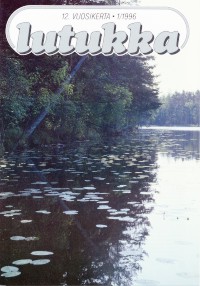 |
Tiivistelmät (englanniksi)
Keskitalo, J. & Heitto, L. 1996: Suurkasvillisuus happamassa ja ruskeavetisessä Valkea-Kotisessa. – Lutukka 12(1):3–8.
Aquatic macrophytes in the acidified brown-water Lake Valkea-Kotinen, southern Finland
Lake Valkea-Kotinen is a small, acidified humic lake (pH 5.2, no alkalinity in the productive layer), which belongs to the International Cooperative Programme on Integrated Monitoring of Air Pollution Effects on Ecosystems. Macrophyte studies were carried out first time on the lake in the connection of the Finnish Research Project on Acidification (HAPRO) in 1986, and they were continued in 1990 and 1994 as a part of the Integrated Monitoring. The main interests in the macrophyte studies have been the effect of acidification, and in general, the characteristics of the vegetation in a small humic forest lake. Steep shores, mud bottom and a high colour value (c. 130 g Pt m-2) restrict the occurrence of macrophytes in Valkea-Kotinen, and consequently the species richness is low. Submersed vascular plants were missing and the depth limit of the vegetation was 1.6 m. The main part of biomass consisted of the floating-leaved vascular plant Nuphar lutea and of the submersed bryophytes Sphagnum spp. and Warnstorfia procera. There were also some Nymphaea candida, Sparganium emersum, Phragmites australis, Fontinalis antipyretica and Batrachospermum sp. The stands of Sphagnum spp. and W. procera became wider during the early 1990s. Sphagnum - when occurring as a submersed plant - is a clear indicator of acidification in Finnish lakes. According to a paleolimnological study, pH of the productive water layer in Valkea-Kotinen has been about one pH-unit higher in the last century up till the 1970s than nowadays. It is evident that the acidification has given competitive advantage to Sphagnum spp. to spread out from the shore to the lake bottom. The airborne acidifying fallout has somewhat de-creased in southern Finland from the 1980s to the 1990s. It may, however, be a long-lasting process until the activities to decrease pollution are reflected in the biota of naturally acid lakes like Valkea-Kotinen, where the buffering capacity against acidity is totally lost.
Saari, V. & Krook, J. 1996: Metsänemä ja muuta uhanalaista lajistoa Lamminahonrinteen lehdossa Pihtiputaalla. – Lutukka 12(1):9–11.
Epipogium aphyllum and other threatened species in Lamminahonrinne in the commune of Pihtipudas, northern Central Finland
Lamminahonrinne is a proposed valuable conservation area of old forests. Its vegetation consists mainly of grass-herb forests and herbrich spruce swamps with a shallow peat-layer. Epipogium aphyllum, Galium triflorum, Elymus caninus and Equisetum pratense are the most valuable vascular plant species, and Schistostega pennata and Dicranum fragilifolium the most valuable moss species. Fruiting bodies of the vulnerable fungus species Haploporus odorus are growing on many sallow trunks. Lobaria pulmonaria is a very common lichen on trunks of deciduous trees in the area.
Kurtto, A. & Helynranta, L. 1996: Helsingin kasveja 1. Yllättäjiä. – Lutukka 12(1):13–18.
Vascular plants of Helsinki 1. Surprising finds
The present vascular flora of Helsinki, the capital of Finland, was mapped accurately in 1990–1995. The results are planned to be published as a series of booklets covering all the taxa, and as a popular book including a selection of the most interesting species. In such compilations it is not possible to treat all the taxa and all the botanically special sites comprehensively. Therefore, a complementary series of articles seems to be useful. This paper is the first one in the series and deals with three species which where unexpectedly found in Helsinki. Until recently Rorippa amphibia was known as a permanent member of the Finnish flora only from a compact area on alluvial shores and in water of the Kokemäenjoki river system in the southwest. There the species is regarded as an archaeophyte immigrated, in one way or another, with Iron Age waterborne traffic. In 1991 R. amphibia was found in Helsinki in shallow pools of a seashore alder grove, and two more stands were discovered elsewhere in Helsinki in the subsequent years. All the three sites are situated at bottoms of bays, into which the sea carries all kinds of material, including diaspores of plants. The only plausible explanation for the origin of the stands of Helsinki is hydrochorous dispersal over the Gulf of Finland, most probably from Estonia. Consequently, the species must now be considered native in Finland. Ligusticum scoticum was found for the first time in Finland in 1968 in the archipelago of Satakunta off the southern west coast. In the following year the species was discovered in the westernmost archipelago of the Åland Islands. Though the plant has increased and also expanded its area in those two provinces, it was not recorded outside them until 1992. It was then found in the eastern archipelago of Helsinki, c. 250 km east of the easternmost locality known previously. When and how L. scoticum reached Helsinki, remains unclear. Today the plant has at least 40 more or less separate occurrences there, some of them quite large. It may nevertheless be a young member in the flora of the area, since it is known to be capable of rapid increase and effective short-distance dispersal. If not deliberately introduced, the species may have immigrated into Helsinki with boats or ships (as mericarps swept overboard?). Senecio inaequidens, a native of South Africa, has increased explosively in the recent decades in Western Europe as an established wool immigrant. The sudden success of the species, which had earlier reached Europe many times but remained only casual for decades, is apparently due to the evolution of a race adapted to the atlantic and subatlantic climates. Now S. inaequidens has a bridgehead as far in the north as on the south coast of Finland: it was discovered in two harbours of Helsinki in 1993. It remains to be seen, whether the plant is hardy enough to survive or even to spread in the boreonemoral city.
Kääntönen, M. 1996: Bruno Florström ja hänen Satakunnan voikukkatutkimuksensa. – Lutukka 12(1):19–23.
Bruno Florström and his Taraxacum flora of the province of Satakunta, W Finland, from 1914
Bruno Florström was a teacher of gymnastics at the Classical Lyceum of Tampere in the early 20th century. Botany was his hobby, and he became familiar with dandelions (Taraxacum) during excursions with Alvar Palmgren to the Åland Islands. In 1910-13 Florström collected an extensive Taraxacum material from Satakunta. Just before the study was printed, he died from typhus in 1914, at the age of 35. With this flora he became a world pioneer in taraxacology, presenting not only the species and their finding places but also data on their ecology, immigration history and native versus alien status in the province. He also described four new species of Taraxacum.
Karhu, N. 1996: Suomukka kotiutunut kylvettynä Lappeenrantaan. – Lutukka 12(1):23–24.
Dynamics of a sown stand of Lathraea squamaria
In 1976 Lathraea squamaria was sown around planted hazels (Corylus avellana) in Lappeenranta, SE Finland, outside its native Finnish range. The first flowering shoot, a solitary one, was detected in 1983. Since then the dynamics of this successful population (probably a single clone) has been characterized by two trends: 1) an average increase in the number of flowering shoots (though the plant has not appeared above ground every year), and 2) a remarkable counterclockwise "travelling" of the stand (or at least of its flowering shoots) around the host.
|
Numero 2/1996
Kirjallisuutta
|
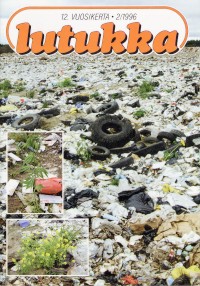 |
Tiivistelmät (englanniksi)
Väre, H.& Huhta, A.-P. 1996 Oulun Pohjanmaan satunnaiskasveja ja vakiintuneita tulokkaita 1990–1995. – Lutukka 12(2):35–40.
Casual alien plants in Oulun Pohjanmaa, northern Finland, in 1990–1995
The casual alien plants (c. 70 species) found in 1990-1995 in the Finnish biogeographical province of Oulun Pohjanmaa (OP; Oulu Ostrobothnia) are listed. Conyza canadensis and Chenopodium rubrum have been collected in the province earlier only before 1951, and it is possible that the former species will be established along the railroad of Lyötty railway station in Oulu, like Artemisia campestris, Epilobium adenocaulon and Senecio viscosus have already done. Brassica napus subsp. oleifera, B. rapa subsp. oleifera, Matricaria recutita and particularly Lolium perenne are the most common casual aliens of the area. In 1994 lawn seed material included Chenopodium ficifolium, Sisymbrium altissimum, Senecio sylvaticus, Bromus tectorum and Amsinckia micrantha, which belong to the rarest aliens of the province. Today most casual alien plants are found in refuse dumps and newly sown lawns. This trend has prevailed since the 1970s.
Kemppainen, E. & Alanen, A. 1996: Planta Europa. – Lutukka 12(2):41–48.
Planta Europa
The first European conference on the conservation of wild plants, organized by Plantlife and the French Ministry for the Environment and called Planta Europa, was held in Hy&egrace;res, France, in 2-8 September, 1995. The conference brought together botanists, conservation practitioners, decision-makers and representatives from all relevant sectors, to build a consensus on how to conserve Europe's wild plant diversity and habitats, especially through the EC Flora, Fauna and Habitats Directive, the Bern Convention and the Convention on Biological Diversity. The main resolutions of the conference are presented here.
Suominen, J. 1996: Etelä-Pohjanmaan köyhä kevätkasvisto. – Lutukka 12(2):49–60.
The poor springtime flora of South Ostrobothnia, W Finland
In comparison with more southern regions, even with S Finland, the species of spring geophytes and therophytes are few and mostly rare in South Ostrobothnia (62° to 63°30' N). Erophila verna is very rare. Arabidopsis thaliana is practically restricted to the coast and archipelago, while Arabidopsis suecica is an old inland immigrant. Gagea minima is rare and appears to be predominantly a recent invader, maybe often intentionally introduced. The old and only finds of native Gagea lutea and Ranunculus ficaria, from Övermark, could not be verified. No native occurrences of any Corydalis have been found in the province.
Myosurus minimus is unexpectedly common in the seed bank. It was hitherto known in about 35 squares of 5 × 5 km, but in the spring 1993 it was found in 24 new squares. To this the early snow cover of the autumn 1992 contributed: in the spring Myosurus was then abundant on unploughed stubble fields on mineral soils near villages.
Out of the some 300 to 400 Finnish microspecies of the Ranunculus auricomus complex, only 25 are known in South Ostrobothnia. Most of these are rare, mainly found far inland and in two harbour towns. Nine more frequent or otherwise interesting microspecis are presented, with a map and a short characterization of ecology and indigenous versus immigrant (usually archaeophytic) status. In several cases the immigration may have been from Sweden across the Gulf of Bothnia, even from as far south as the Stockholm region.
Piirainen, M. 1996: Itä-Enontekiön kaatopaikkakasveista. – Lutukka 12(2):62–63.
On the vascular plants of five refuse pits in Enontekiö, western Finnish Lapland
Five refuse pits in Enontekiö Lapland were shortly visited in 1994 and 1995. The vascular plant taxa were listed with special interest in anthropochorous species. The numbers of archaeophytes and established aliens in the 71 taxa listed were rather high. Helianthus annuus and probably also Lycopersicon esculentum and Solanum tuberosum were recorded for the first time as casual aliens in the province. Leymus arenarius was probably also recorded for the first time as a casual alien in Enontekiö Lapland; it has been known only as an archaeophyte in an eroded 'fossile' dune field in the easternmost parts of the province.
|
Numero 3/1996
Kasvihavaintoja
Kirjallisuutta
|
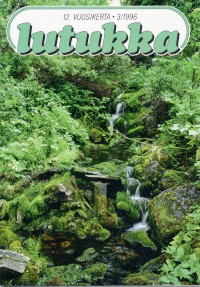 |
Tiivistelmät (englanniksi)
Piirainen, M. 1996: Termislehto - keidas keskellä karua Enontekiön Maanselkää. – Lutukka 12(3):67–72.
Termislehto - an oasis in the Enontekiö watershed, northern Finland
The terrain in the eastern parts of Enontekiö parish, western Finnish Lapland, is mostly rather flat, with wide marsh areas and low fjelds. Eroded 'fossile' dune fields and esker ridges are also characteristic. The area is surprisingly poorly known floristically. One of the few sites better known by botanists is Termislehto, a luxuriant forest area at the western margin of Termisvarri fjeld, near the Norwegian border north of Hetta village. The first botanist to visit Termislehto was A. J. Malmberg (later Mela) in 1867. In the 1960s a group of botanists published a short floristic note on the area. In 1971 the site was visited by botanists from the Botanical Museum of Oulu University. Together their and the author's floristic notes cover 144 vascular plant taxa. Among these are many rather demanding species but no real rarities or threatened taxa. Termislehto was preserved as a 'primeval forest area' by the National Board of Forestry in 1968. It is also included in the national program for grove protection.
Piirainen, M. & Nurmi, J. 1996: Miekkavihvilä (Juncus ensifolius) vakiintuneena tulokkaana Varsinais-Suomessa. – Lutukka 12(3):74–77.
Two established occurrences of Juncus ensifolius in southern Finland
Two localities of the mainly North American species Juncus ensifolius Wikström are reported, from Kisko and Vihti parishes, southern Finland. On both sites the species is growing in a roadside ditch of a road that has been constructed in the late 1960s - early 1970s. The exact origin of the species on these sites cannot be traced anymore. It seems probable that it has immigrated with North American Agrostis seed commonly used for grassing of the roadbanks in those times. This also seems to be the origin of the earlier findings of the species in Finland and in Sweden. The history of Juncus ensifolius in Europe is shortly reviewed. The species seems to be on its way to a well established and at least partly naturalized alien in Europe. The first European finding is from England in 1956, and from the 1970s onwards the species has been found in several localities in, at least, the Netherlands, Luxembourg, Germany and Sweden. In Finland the species was found for the first time in 1971 in Espoo town, southern Finland, and in 1975 in Kuusamo parish, north-eastern Finland. The species was still growing in Espoo at least in 1983, but in September 1996 it could not be found. The Kuusamo population seems to have been a more short-lived one.
Arkkio, H. & Kääntönen, M. 1996: "Peltonukki" (Androsace elongata) Nokialla (EH) – uusi laji Suomelle. – Lutukka 12(3):77–78.
Androsace elongata found in Finland
A large population (several hundreds of plants) of Androsace elongata L. was detected on a sandy slope in Nokia, southern Finnish inland, in 1996. The vector of immigration is not known (perhaps grass seed). There are no earlier records of the species from Finland.
Jutila, H. 1996: Noidanlukkojahtia Satakunnan perinnemaisemilla. – Lutukka 12(3):79–84.
Recent finds of Botrychium in Satakunta, W Finland
In Satakunta, like elsewhere in Finland, the ceased grazing of dry grasslands has caused a strong decline of Botrychium species, all except B. lunaria being now threatened in Satakunta. The finds presented here date from an inventory of valuable old pastures made in 1992-1995.. Nine localities are described for B. lunaria, two for B. multifidum, and two for B. boreale. Most of the records are from 1994, probably due to the rainy and cool June and warm July
Kemppainen, E. & Ryttäri, T. 1996: Kasvipopulaatiobiologit koolla Seilissä maaliskuussa 1996. – Lutukka 12(3):85–88.
A meeting of plant population biologists
Finnish plant population biology researchers had their annual meeting in Seili Research Station, Nauvo, in 21–23 March 1996. The presentations given there are briefly summarized.
|
Numero 4/1996
Kasvihavaintoja
|
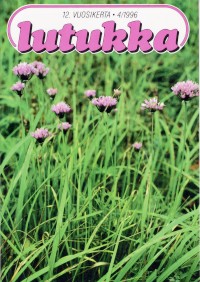 |
Tiivistelmät (englanniksi)
Ulvinen, T. 1996: Tornion Kalkkimaan saksalaiskasveista ja vähän muistakin. – Lutukka 12(4):99–109.
German polemochores at Kalkkimaa in Tornio, northern Finland
During the Second World War (1941–1944) German military troops used the end of the railroad to Kalkkimaa lime quarry in Tornio as a storage area. Corn and fodder were imported from Central Europe and many plants immigrated with them. The paper summarizes the investigation history of the polemochores of the area. After more than 50 years since their arrival a large number of wartime immigrants are still thriving there. They include, e.g., Alchemilla gracilis, Bromus inermis, Cardaminopsis arenosa, Centaurea jacea, Euphorbia esula, Galium × pomeranicum, Heracleum sphondylium subsp. sphondylium, Hypericum maculatum, H. perforatum, Pimpinella major, Plantago media, Potentilla thuringiaca, Primula elatior, Thymus pulegioides, Trifolium medium, and Vicia sepium subsp. sepium. The most interesting species is Allium angulosum, which is a native eastern plant of moist meadows. Kalkkimaa is the only locality in Finland where the plant is still growing in its original immigration locality. A number of species is known to have survived shorter times in the area. Numerous common anthropochores immigrated with German troops, too. Mr. A. Railonsala, who studied the Taraxacum flora on polemochore sites in northern Finland in the 1960s, collected at Kalkkimaa a large number of Taraxacum species, and 15 species described by him have their type localities at Kalkkimaa. Now, the area and other wartime camps with polemochores are threatened by overgrowth. Kalkkimaa is also known for some other rare anthropochores, which were growing there already at the beginning of this century and are still present, e.g. Campanula rapunculoides, Centaurea scabiosa, Gentianella amarella and Knautia arvensis. The indigenous flora of the Kalkkimaa area includes several rare calciphilous species, e.g. Botrychium virginianum, Calypso bulbosa, Cypripedium calceolus and Microstylis monophyllos. Also Gentianella campestris belongs there to the native flora (elsewhere in Finland at least predominantly an archaeophyte). Cystopteris montana and Polygonatum odoratum have disappeared from the lime quarry area.
Piirainen, M. 1996: Alppihierakka (Rumex alpinus) vakiintuneena Espoossa. – Lutukka 12(4):110–112.
Rumex alpinus as an established escape from cultivation in Espoo, southern Finland
The Central and southern European mountain plant Rumex alpinus L. is reported from two localities in Espoo, southernmost Finland, as new to the province of Uusimaa. The species had so far been known as established in three localities in southern Finland. Probably all these occurrences are relics of or escapes from earlier cultivation. In addition, Rumex alpinus has been found as a casual in two German World War II camp sites in northern Finland. In the Nordic Countries outside Finland, the species is known as an escape from cultivation in one locality in Norway (Tromsø). However, Flora Europaea and Atlas Florae Europaeae give no records from any of the Nordic Countries.
Lampolahti, J. & Suominen, J. 1996: Rantaputki myötätuulessa Pohjanlahdella. – Lutukka 12(4):115–118.
Ligusticum scoticum spreading along the east coast of the Gulf of Bothnia
On shores of the Baltic Sea Ligusticum scoticum is a recent immigrant. It was first found on the Swedish coast of the Gulf of Bothnia in 1943. Since then it has been spreading continuously, chiefly by hydrochory. In Finland it was first found in Merikarvia (Sastmola, province St) on an islet off the east coast of the Gulf of Bothnia in 1968. Up to 1988 Ligusticum was known from eight islets in the Oura Archipelago (Skarvsörarna), all close to the first finding. Oura seems to be the first foothold and acts as a local spreading centre. Admittedly, the surrounding island groups stayed botanically almost unexplored until the late 1980s. The number of known sites of Ligusticum was tripled in 1989-1996 mainly due to intensified field work. Half of the total of 26 records are from the Oura Archipelago, and only three southwards from Oura. The southernmost, solitary find in Luvia lies 46 km apart from Oura. However, ten localities are situated north of Oura, in the direction of prevailing sea currents and winds. The most distant place northwards lies off the town Kristiinankaupunki (Kristinestad, province EP), 22 km apart from the others. The length of the new known range along the Finnish west coast is 99 km, but most finds lie within 30 km. All sites are stony and gravelly shores exposed to the open sea in the outer archipelago. At times of high water levels and during storms they are reached by splashes of brackish water. Undoubtedly numerous sites still remain to be revealed both within and outside the presently known range. It is predicted that Ligusticum will continue to spread. Sailing away northwards till Merenkurkku (Kvarken), the plant will be washed ashore in a paradise, i.e. in a vast archipelago rich in stony shores.
Lampolahti, J. 1996: Keltavuokon kannoilla Satakunnassa. – Lutukka 12(4):119–120.
Some finds of Anemone ranunculoides in Satakunta, SW Finland
In the biogeographical province of Satakunta Anemone ranunculoides is native only in the easternmost parts. Three localities in the western part of the province along the River Eurajoki were visited in 1996. All the localities are situated in groves near old manors. If no further finds emerge from the area, the plant should be considered there an established alien introduced as an ornamental in the 19th century.
Lahtonen, T. 1996 "Pikkusorsimo" (Glyceria declinata) Suomenlinnassa. – Lutukka 12(4):121–122.
Glyceria declinata in Helsinki, southern Finland
Glyceria declinata Bréb. was found as an apparently established population by a pond in the area of the sea fortress of Suomenlinna in Helsinki in 1995. Also Glyceria striata (the only occurrence in Finland) and G. notata (G. plicata), a southern rarity in Finland, were growing at the same site. The origin of this remarkable conglomeration of species is unknown. G. declinata has been found in Finland once before, as a casual ballast immigrant in Helsinki in 1889.
Kurtto, A. 1996: "Kanadansorsimo" (Glyceria canadensis) Vantaalla ja Helsingissä. – Lutukka 12(4):123–124.
Glyceria canadensis as an established alien in Finland
Glyceria canadensis (Michx) Trin. is a native of northeastern USA and adjacent Canada. It is growing as an established alien in and along ditches and on moist wasteland like patches by a motorway on both sides of the boundary between Helsinki and Vantaa, predominantly in the area of the latter town, on the southern coast of Finland. The species was probably brought in with North American hay seed used for the grassing of the highway banks in the early 1970s. In this respect G. canadensis seems to resemble another North American wetland plant, viz. Juncus ensifolius, which has at least two established populations in Finland.
Vuosikerran 11 sisältö (1995)
|
Numero 1/1995
|
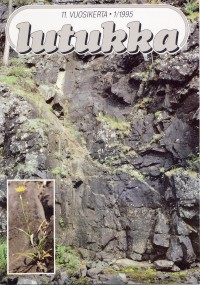 |
Tiivistelmät (englanniksi)
Kemppainen, E. 1995: Mitä kuuluu uhanalaisille putkilokasveille ja niiden suojelulle. – Lutukka 11(1):3–20.
Review of the conservation, management and monitoring of the threatened vascular plants in Finland in 1992–1994
Systematic work for the conservation of threatened species in Finland has been carried out since 1983. Conservation programmes have been prepared for most of the nationally endangered and vulnerable vascular plants by the WWF Plant Group. Thus far two conservation programmes (Thalictrum aquilegiifolium and Bromus benekenii) have been confirmed by the Ministry of the Environment, 16 others are almost finished and about 40 are under preparation. Many amateur botanists, scientists at universities and some local authorities have monitored the sites, done management experiments and given information for this article. Some information has already been fed into the database of threatened species. Sites of the plants considered to be in need of monitoring as well as the sites of regionally threatened plants should be inventoried more carefully than has been done. The biology and ecology of nearly all the threatened plants are poorly known.
Kemppainen, E., Kaipiainen, H. & Alanen, A. 1995: Kuulumisia uhanalaistyöstä. – Lutukka 11(1):21–25.
New organization of the Finnish nature conservation work
The new organization of the Finnish nature conservation work, especially the establishment of the Finnish Environment Agency and the 13 regional Environment Centers of Finland on the 1st of March 1995 is presented. Information on the current status and volume of the data base of the Finnish threatened species is also given.
Jutila, H. 1995: Rauman Reksaaren nummimataraesiintymien tila kesällä 1994. – Lutukka 11(1):26–31.
The state of Galium saxatile in Reksaari, archipelago of Rauma, SW Finland, in 1994
Galium saxatile L. is classified as a nationally endangered plant in Finland. Its most vigorous Finnish population is known from Reksaari, an island in the archipelago of Rauma in the southwest. The species was found there already in the early 1960s, but accurate monitoring of the population began as recently as at the end of the 1980s. In the summer of 1994 the population consisted of eight stands with the total area of 38 m2. The habitat of six of the stands is a former forest pasture with coppiced trees. One stand is growing in the yard of a summer cottage and another one along a path more than a kilometre away from the seven others. The vegetation of the sites of Galium saxatile is rich in species and is dominated by Agrostis capillaris, Deschampsia flexuosa, Melampyrum pratense, M. sylvaticum, Vaccinium myrtillus, Rubus saxatilis and Oxalis acetosella.
Since the beginning of the monitoring the total number of shoots of the population of G. saxatile has increased. Also two new (or formerly overlooked) stands were detected in 1994. The flowering of G. saxatile is promoted by light. So, in 1994 the flowering was most abundant under a power line where junipers had been cut down four years earlier. According to small-scale experiments the mowing of the field layer seems to be an effective measure to manage the stands of G. saxatile, since it apparently increases both the number of shoots and the number of flowers in the plant. Additional experimental and control plots were established in 1994 in order to elucidate more accurately the factors affecting the survival and reproductive strategies (seed bank, seed rain, vegetative propagation, survival of seedlings etc.) of G. saxatile. Some of the experimental plots were only mowed, from others a small patch of the surface soil was removed as well.
|
Numero 2/1995
Kasvihavaintoja
Kirjallisuutta
|
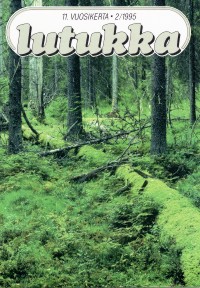 |
Tiivistelmät (englanniksi)
Kääntönen, M. 1995: Kansallismaiseman kasvistoa – Tampellan teollisuusalueen lajistoa Tampereella (EH). – Lutukka 11(2):35–41.
Vascular plants of the Tampella factory area in Tampere, southern Finland
The floras of old factory areas have been studied in Tampere, southern Finland, for the evaluation of environmental effects of various measures proposed in city planning. In the Tampella factory area 196 wild vascular plant species and 70 ornamentals were found. In addition to common weeds and ruderals, the wild flora included companions of old settlements (e.g. Juncus compressus, Puccinellia distans subsp. distans, Convolvulus arvensis), plants of rock outcrops and herb-rich grasslands, and neophytes immigrated with coal and trains (e.g. Conyza canadensis, Herniaria glabra, Hordeum jubatum, Lactuca serriola, Melilotus altissimus). A small community of shore and water plants was established in a wet depression of a rock outcrop.
Industrial activity has affected the Tampella area for c. 160 years. The area belongs to the nationally valuable landscapes reflecting the Finnish cultural history. However, its rich flora will most probably be much impoverished by the planned new residential area with streets, houses and plantations.
Anttila, S., Uimonen, J. & Vehmaa, P. 1995: Käävät aarniometsien ilmentäjinä Kainuun kuusikoissa. – Lutukka 11(2):42–48.
Polypores on decomposing spruce trunks in some old forests of eastern Central Finland
Old, virgin forests are nowadays very scarce in Finland outside nature reserves. Recently special inventories of such forests have been carried out, and they are expected to be completed this year. The inventories have concentrated on the description of the trees, both living and dead, including fallen and decomposing trunks. When possible, organisms inhabiting the forests have been listed. Polypores or bracket fungi and their relatives are among the most important groups of organisms indicating the age, degree of undisturbance and conservation value of old forests. In Kainuu and North Karelia in eastern Central Finland the polypores present on decomposing fallen trunks of Norway spruce (Picea abies) in selected areas of old forests were inventoried in order to find an indicator method based on species which are (fairly) easy to identify and not too rare. Although the material proved insufficient for deepgoing statistical analyses, significant associations between several species pairs were detected using rank correlations. The presence of stout trunks was especially important to many species, a fact, which has been noticed in some previous studies, too. In the evaluation of the conservation value of old forests both the description of trees and the inventory of polypore species are needed, since they complement each other and thus increase the reliability of the evaluation.
Räsänen, J. 1995: Kasviharrastajan kesä 1994 Pohjois-Karjalassa. – Lutukka 11(2):49–56.
Summer of an amateur botanist in North Karelia, eastern Finland
In the summer of 1994 the author concentrated his field work to the complementing of the data of the national distribution mapping of vascular plants (Atlas of the distribution of vascular plants in Finland). The principal study areas were the commune of Outokumpu and the town of Joensuu in the biogeographical province of North Karelia in the eastern central part of the country. In Joensuu Bromus tectorum and Vulpia myuros, which are rare casuals in Finland, were found for the first time in the province. They had immigrated with grass seed used for new lawns. Many native plants or established aliens, which are rare in the province, were found in the study areas, e.g. Artemisia campestris, Herniaria glabra, Ceratophyllum demersum, Apera spica-venti, Stratiotes aloides, Myriophyllum sibiricum, Lemna trisulca, Lathyrus palustris, Bidens cernua, Festuca trachyphylla and Bunias orientalis. The presence of Eupatorium cannabinum in the commune of Kesälahti was confirmed (latest record before this from the 1930's). Verbascum thapsus is growing at one site in Kesälahti as an apparent archaeophyte; the species has been regarded as a casual in the province.
Many meadow plants have recently decreased in North Karelia, even such species as Campanula rotundifolia, Antennaria dioica and Nardus stricta. On the other hand some neophytes have rapidly increased, most notably Epilobium adenocaulon, E. ciliatum and Impatiens glandulifera. Scirpus radicans, Oxytropis campestris subsp. sordida and Lactuca sibirica have old, strong and stable populations in and around Joensuu.
Kurtto, A. 1995: Hiirenhäntänadasta ja muistakin uudisnurmikkojen kasveista. – Lutukka 11(2):56–58.
On some new immigrants on new lawns in Finland
The annual grasses Vulpia myuros, Bromus tectorum and B. hordeaceus have been observed recently as casual, but at some sites even abundant lawn seed immigrants at least in the towns of Helsinki and Joensuu in Finland. The Vulpia species, which is nowadays an almost cosmopolitan weed, has been recorded earlier only a couple of times in Finland. In 1983 it was found on a new roadside lawn in the commune of Kangasniemi, Central Finland, together with Lobelia kalmii, a native of North America, and Parentucellia viscosa originating from the Old World, but today also present in North America. Bromus tectorum has earlier immigrated into Finland almost solely with imported grain, but for B. hordeaceus lawn seed is not a new vector. Anthoxanthum aristatum, which had only a single earlier record from Finland, was fairly abundant on a new lawn in Helsinki in 1994. Plagiobothrys scouleri, a North American species of the family Boraginaceae, reached Helsinki in lawn seed in 1991. This species was found in Finland for the first time in 1983. Other recent weeds, both common and rare, of the new lawns in Helsinki are listed. The exotic species mentioned above have certainly immigrated with lawn seed from abroad, but often the bulk of weeds on lawns is of domestic or local origin (e.g. transported with soil or/and sludge from sewage treatment plants, from seed bank or escaped from nearby gardens).
|
Numero 3/1995
Kasvihavaintoja
Kirjallisuutta
|
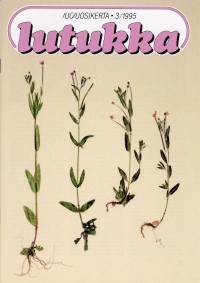 |
Tiivistelmät (englanniksi)
Laine, U. & Saxén, B. 1995: Harmaa- ja tummahorsman sekä eräiden muiden Epilobium-lajien ja niiden risteymien nykytilanteesta Korppoossa ja Nauvossa. – Lutukka 11(3):67–76.
The recent occurrences of some rare and threatened Epilobium species, especially E. lamyi and E. obscurum, with a few hybrids, in the communes of Korppoo and Nauvo, SW Finland
At present, Epilobium lamyi F.W. Schultz and E. obscurum Schreber are in Finland nearly exclusively restricted to the communes of Korppoo (Korpo) and Nauvo (Nagu) within the province of Varsinais-Suomi, SW archipelago of Finland. Both species have declined during the last decades, and they are classified as in need of monitoring (E. lamyi) or vulnerable (E. obscurum) in Finland. They have been protected by law since 1989. Their ecology is discussed and their localities are mapped. Both species may be of archaeophytic origin because they always occur on disturbed soil, chiefly in roadside and field ditches and other man-made habitats. E. lamyi favours rather dry ditches with a clay bottom whereas the habitats of E. obscurum are often wet and partly influenced by spring waters. Today E. lamyi is known in five localities in Korppoo and two in Nauvo where it has at least five different sites on the island of Seili. E. obscurum grows in three places in Korppoo and in five in Nauvo. E. lamyi is known in Korppoo since 1885 and in Nauvo since at least 1904. Elsewhere in Finland it has not been found recently, not even on the Åland Islands. Besides Korppoo and Nauvo, E. obscurum grows only very sparsely in Lohja. The numbers of the shoots of the two species in different localities have been checked in 1989-1993 and the results are summarized in two tables. The determination of annual individuals of E. lamyi and E. obscurum is more difficult than those of perennial plants. Many colonies seem to be vigorous but the number of individuals fluctuates considerably from year to year. The decrease may be due to cessation of pasturing and increased competition of shrubs, grasses and herbs. Today the greatest threats are subsurface drainage, roadside cutting machines and, probably, agricultural herbicides. Obviously, these species make benefit of light ploughing of ditches.
E. parviflorum and E. glandulosum are reported for the first time from the SW archipelago. E. roseum has one locality here, too. New hybrids to Finland are E. adenocaulon × lamyi, E. adenocaulon × obscurum, E. adenocaulon × roseum and E. montanum × obscurum.
Saarinen, K. 1995: Lappeenrannan linnoituksen kasveista, vanhaa ja uutta. – Lutukka 11(3):77–86.
On the vegetation of the Lappeenranta fortress, SE Finland
The town Lappeenranta in SE Finland has been, and still is, a gate between east and west. A sandy hill within the present city was fortified in the 18th century. Then the fortress was ruled, from time to time, by both Swedish and Russian armies. With horse fodder and other transports numerous alien plants immigrated, and many of these still flourish. The majority came from the east, the best established eastern immigrants including Berteroa incana, Bunias orientalis, Dracocephalum triflorum and Bromus inermis.
In addition to the polemochores, the fortress is a site of many plants favouring old and intense human influence. Since the 15th century Lappeenranta was an important market place at an ancient road junction. The presence of Pastinaca sativa, Armoraria rusticana, Hyoscyamus niger and many others is due to old trade connections.
The vegetation of the fortress was surveyed in the early 1960ies. The main part of the 250 plant species are immigrants. During the recent 30 years, the flora and vegetation have undergone considerable changes. Many plants of rich soils, in particular, have disappeared, e.g. Atriplex patula, Solanum nigrum, Urtica urens and Asperugo procumbens. On the other hand, plants like Conyza canadensis, Melilotus spp. and Chaenorhinum minus are newcomers of roadsides.
Laine, U. 1995: Pöytälaatikkooni unohtuneita tulokaskasvihavaintoja Varsinais-Suomesta (V). – Lutukka 11(3):87–90.
Rare alien plants in the province of Varsinais-Suomi (V), southwestern Finland
The following plants are recorded for the first time from Finland (possible means of immigration in parentheses): Erodium crinitum Carolin (Australian wool), Hedysarum spinosissimum L. (ballast), Phalacrachena inuloides (Fischer ex Janka) Iljin (imported grain, apparently Ukrainian wheat). Senecio erucifolius L. was found as a grass seed immigrant or an escape from a botanical garden. There are only a couple of earlier records of the species from Finland. Only Phalacrachena is locally established, the others remained strictly casual.
Kurtto, A. 1995: Eksoottisia vuotatulokkaita Hämeenlinnassa 1960. – Lutukka 11(3):91–93.
Wool immigrants in Hämeenlinna, southern Finland
Nine exotic plant species were collected at the mouth of the drain of a fur-dressing factory in Hämeenlinna, southern inland of Finland, in 1960. The plants had immigrated with (sheep) pelts, one species from Australia (Rumex brownii) and two from South America (Diplachne uninervia, Digitaria aequiglumis). The remaining six species (Bromus rigidus, Echium plantagineum, Lythrum hyssopifolia, Plantago coronopus, Polypogon monspeliensis, Vulpia myuros) are nowadays more or less cosmopolitan, and thus might have immigrated from either or both of the continents mentioned, or from elsewhere (e.g. the Mediterranean).
|
Numero 4/1995
Kasvihavaintoja
Kirjallisuutta
|
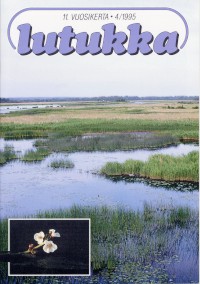 |
Tiivistelmät (englanniksi)
Saarnio, S. & Saarinen, K. 1995: Kolvananuuron (PK) rotkolaakson kasvistosta. – Lutukka 11(4):99–107.
Flora of the Kolvananuuro gorge, E Finland
The long and narrow gorge is characterized by high and steep rock precipices and boulder beds and by ponds, peatlands and a brook at its bottom. The post-glacial history of the flora lead to southern and northern plants growing side by side in the gorge. Southern species are exemplified by Actaea spicata, Galium odoratum, Polygonatum odoratum and Sedum telephium, northern ones by Cerastium alpinum, Saxifraga nivalis and Woodsia alpina. As a site of many local rarities and as a memorial of flora history the gorge has been protected.
Ulvinen, T. & Halonen, P. 1995: Tärvelty Kitisen Sakatinpahta. – Lutukka 11(4):108–114.
Sakatinpahta, a spoiled cliff on the shore of Kitinen river in Finnish Lapland
Sakatinpahta cliff on the shore of Kitinen river in Sodankylä (biogeographical province of Sompion Lappi) has ultramafic volcanic rocks with an agglomerate structure, which gives a suitable site for many interesting plants and lichens. The first botanist who visited the locality was R. Hult in 1890. In 1995 Draba daurica, Potentilla crantzii and Elymus mutabilis were refound. Of mosses some (Hypnum callichroum, Homalia trichomanoides) were not found again, but a number of new records were made (Anomodon longifolius, A. viticulosus, Brachythecium glareosum, Encalypta brevicollis, E. procera, E. rhaptocarpa, Orthotrichum alpestre, O. rupestre, Pseudoleskeella papillosa, Tortella fragilis, Porella platyphylla). For 6 bryophyte species the locality is the only one in the province of Sompion Lappi. 12 species of bryophytes are regionally threatened and two of them (Encalypta procera and Pseudoleskeella papillosa) are also nationally threatened. Of lichens, the site is the only one in Sompion Lappi for 9 species (Caloplaca saxicola, C. obliterans, Candelariella aurella, Dermatocarpon miniatum, Heterodermia speciosa, Lecanora dispersa, Melanelia fuliginosa, M. subargentifera, Polychidium muscicola). Six species of lichens are regionally threatened and two of them (Heterodermia speciosa and Lobaria scrobiculata) are also nationally threatened. In the Kitinen river a series of hydro-electric power stations with dams have been built. Lower parts of Sakatinpahta cliff with many sites of rare and threatened plants and lichens were drowned in the new Matarakoski basin in the autumn of 1995.
Lampolahti, J. 1995:Hentokiurunkannus Satakunnan rannikolla. – Lutukka 11(4):115–116.
Corydalis intermedia in the province of Satakunta, SW Finland
Two recent finds of Corydalis intermedia in luxuriant groves near the coast of the Gulf of Bothnia are presented. There are four previous records of this early-flowering geophyte in the province of Satakunta. At the northernmost locality it was found to be more abundant than previously noticed.
Hintikka, V. 1995: Hoikkarölli (Agrostis clavata) Jyväskylässä (PH). – Lutukka 11(4):116–117.
Agrostis clavata found in Jyväskylä, Central Finland
This boreal grass was found in 1994 and 1995 close to the city of Jyväskylä, growing in a clear-cut area of a mesic forest, on soil disturbed by logging machines.
Toivonen, T. 1995: Kasviston muutoksista Someron Salkolassa ja Äyräsnummella 1951–1994. – Lutukka 11(4):118–120.
Floristic changes in Somero, SW Finland
Since the 1950s many plant species disappeared from mown and grazed grasslands, now overgrown, and from drained, especially rich peatlands, and from fields and abandoned yards. Other species invaded the areas, due to a new highway and to ditches and other disturbed ground. On a sandy esker many plants declined under a dense forest while in construction areas new stands seem to have germinated from seed bank. Similar changes occurred all over Finland. In this particular case, however, the basis is unusually firm because the old and recent observations were made by the same person.
Lilja, V. 1995:Porin kaupunkikasveista ja -kasvillisuudesta. – Lutukka 11(4):123–125.
Vegetation of town grasslands in Pori, SW Finland
Vegetation was analyzed in the city area from different kinds of artificial open habitats without cultivation or management. Archaeophytic species were particularly numerous. The diversity of species was highest in recently abandoned fields and other sites with clay substrate, and lowest at parkmeadows. Six different species composition groups were separated, mainly determined by land use. A peculiar flora was found in the Karjaranta railway yard, with many railway incomers.
Vuosikerran 10 sisältö (1994)
|
Numero 1/1994
Kasvihavaintoja
Kirjallisuutta
|
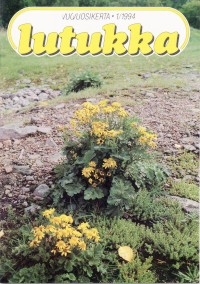 |
Tiivistelmät (englanniksi)
Kalinainen, P. & Lampolahti, J. 1994:Porin Reposaaren painolastikasvit – kulttuuriaarre merten ja aikojen takaa. – Lutukka 10(1):3–12.
The ballast flora of the Island Reposaari (Räfsö), off Pori, SW Finland
Reposaari was the most important Finnish timber harbour for many years in the late 1800's. The ballast fields comprised about 50 hectares. Trading ceased in the 1910's but Reposaari has remained an idyllic fishing harbour town to the present day. It is the only Finnish harbour with a flourishing ballast flora, the sole haven of moribund ballast plants like Carduus nutans, Melilotus altissimus and Senecio jacobaea. A good half of the ballast plants (75 out of 135 species) became established in Reposaari, and eight species survive in a seed bank.
Saarinen, K. 1994: Isohierakka (Rumex hydrolapathum) Saimaan kanavalla (ES). – Lutukka 10(1):14–17.
Rumex hydrolapathum in Lappeenranta, southeastern Finland
Rumex hydrolapathum Hudson, a southwestern species in Finland, was found in 1987 in Lappeenranta as new to the biogeographical province of South Savo. The habitats are crevices of the stony banks of the Saimaa Canal. The species seems to have immigrated with cargo ships from the Gulf of Finland, apparently fairly recently, and is now well established.
Ahokas, H. 1994: Uhanalaisen hukkariisin (Leersia oryzoides) nykytila Suomessa. – Lutukka 10(1):18–20.
On the present state of the endangered Cut Grass (Leersia oryzoides) in Finland
Leersia oryzoides (L.) Swartz was found in 1931 for the first time in the present territory of Finland on the shores of the Turanlahti bay on the island of Mussalo in Kotka in the southeastern part of the country. Some other stands were detected in nearby shores some years later. The Finnish distribution is marginal for the species and consists of patchlike occurrences in a small area reaching from Ahvenkoski in Ruotsinpyhtää in the west into the mouth of the River Nummenjoki in Kotka and Vehkalahti in the east.
In the 1930s Leersia oryzoides was fairly abundant on the shores of the Turanlahti bay in Kotka, but has declined strongly and may now be extinct. All the other Finnish stands of the species are threatened, too. The causes of the decline may rather be chemical or biotic than merely physical, since there are still suitable habitats in the areas previously occupied by the species.
Kuitunen, T. & Lahtonen, T. 1994: Jyväskylän Viherlandian kauppapuutarhan kasvihuonerikat. – Lutukka 10(1):21–28.
Greenhouse weeds in a market garden in Jyväskylä, Central Finland, in 1984–1992
The greenhouse weeds in the market garden of Viherlandia in Jyväskylä have been observed since the opening of the garden at the beginning of 1984. A majority of the 55 species identified is of European or Eurasian origin. However, many of these, as well as of those originating from other continents, are nowadays cosmopolitan weeds. The most exotic species have immigrated from tropical or subtropical regions with imported palms, fern trees and bonsai plants. This element includes Centipeda minima, Eragrostis multicaulis, Fatoua villosa, Mazus japonicus, Vandellia crustacea and Youngia japonica from the Far East, and Phyllanthus amarus, Lindernia grandiflora and Digitaria horizontalis from the New World.
|
Numero 2/1994
Kasvihavaintoja
Kirjallisuutta
|
|
Tiivistelmät (englanniksi)
Hinneri, S. 1994: Kedot ja ketokasvit - lounaissuomalainen näkökulma. – Lutukka 10(2):35–40.
On species composition of herb-rich grasslands in old settlement areas of SW Finland
The archipelago and coastal areas of SW Finland, often called the oak zone, are characterized by herb-rich grasslands confined to old settlements originating from the Iron Age or early Middle Ages. These grasslands or dry meadows are rich in archaeophytes, i.e. established aliens of ancient times. Among herbs Dianthus deltoides, Filipendula vulgaris, Plantago lanceolata, Leucanthemum vulgare and Ranunculus polyanthemos are common and almost exclusively confined to these vegetation types. Festuca ovina, Avenula pratensis, Poa compressa, Bromus hordeaceus and Luzula campestris are their counterparts among graminides. On the other hand, many indigenous grasses (Poa angustifolia, Deschampsia flexuosa, Anthoxanthum odoratum, Danthonia decumbens etc.) and herbs (Galium verum, Achillea millefolium, Potentilla argentea, Lychnis viscaria and Hypericum perforatum among others) are well-represented. The great species diversity is an easily recognizable peculiarity differentiating these grasslands from common dry grasslands, often collectively united into the Agrostis capillaris meadow type.
According to Finnish phytogeographical tradition species-rich vegetation on thin soil covering rocky sites as well as on trampled sandy sites in old villages, is included in the same vegetation category (so-called "keto") with above-mentioned true grasslands. The great species diversity of these marginal sites is mainly due to the great amount of therophytes. Most of them, e.g. Veronica arvensis, Vicia tetrasperma, Scleranthus annuus, Arenaria serpyllifolia, Cerastium semidecandrum, Trifolium arvense and Geranium pusillum, as well as both diagnostic grasses Bromus hordeaceus and Poa compressa belong to the archaeophyte flora of the study area.
The species-richest plant communities in Finland are found evidently among the herb-rich grasslands in several study areas more than 30 vascular plant species per a sample area of 12 m2 were counted.
Hinneri, S. & Lehtomaa, L. 1994: Ketokasvien ekologiasta lounaisrannikolla ja -saaristossa. – Lutukka 10(2):41–50.
Species distribution and environmental factors in herb-rich grasslands in coastal and archipelago areas of SW Finland
Relations between grasses and herbs of species-rich grasslands and environmental variables in coastal and archipelago areas of SW Finland were explored using canonical correspondence analysis (CCA). The age of settlement was the most important factor influencing species distribution. Grasslands at inland villages originating from the younger Iron Age include archaeophytes, e.g. Silene latifolia, Hypochoeris maculata, Armeria maritima and Odontites vulgaris, but there are also Lychnis viscaria, Antennaria dioica and Lathyrus linifolius and other apophytes originating from ecotones and gaps of pine and oak forests. As seen from the species composition, the oldest settlement is concentrated on esker and finesand-rich drumlins.
Avenula pratensis, regionally replaced by A. pubescens, reaches its greatest abundance on mull-rich soils of stony hillsides in old villages in both coastal and archipelago areas. The most prominent herbs Filipendula vulgaris, Ranunculus polyanthemos and Centaurea jacea are also archaeophytes, whereas patches of Silene nutans and Lotus corniculatus, both apophytes, are diagnostic of eroded sites without a humus layer. A subgroup characterized by Briza media, Polygala vulgaris and Vincetoxicum hirundinaria is confined to younger soils of outer archipelago areas.
The archaeophyte group of Poa compressa, Carex spicata, Plantago lanceolata, Ranunculus bulbosus, Alchemilla glaucescensv and Trifolium arvense is restricted to base-rich soils of archipelago villages. These species are accopanied by Geranium sanguineum, Origanum vulgare, Agrimonia eupatoria, Melampyrum cristatum and Arabis hirsuta known as xerothermic southeastern geoelement in the Baltic archipelago areas.
Many therophytes find their safe sites on thin soil covers in rocky places or trampled sandy ground, being exposed to water-defiency stress during rainless periods. Base-rich sites are recognizable by Bromus hordeaceus, Cerastium semidecandrum, Arenaria serpyllifolia and Geranium pusillum, whereas Scleranthus annuus, Myosotis ramosissima, M. stricta, Veronica arvensis, V. verna and Viola tricolor are able to tolerate a more acid substrate. Among perennial herbs Sedum album, Trifolium montanum and Veronica spicata prefer soils with a neutral reaction or nearly so, but Sedum acre and Saxifraga granulata are found also on more acid sites.
The main bulk of species is, however, exhibiting a wide amplitude or avoiding extreme conditions. Among them Luzula campestris, Dianthus deltoides, Galium verum, Leucanthemum vulgare, Campanula rotundifolia, Allium oleraceum and Arabis glabra are representing the core assemblage of herbs in anthropogenic grasslands.
Kukkonen, I. 1994: Poutajoen laakso - ajatuksia maiseman ja kasvillisuuden historiasta. – Lutukka 10(2):51–57.
Valley of River Poutajoki in Paimio, SW Finland – thoughts on the history of landscape and vegetation
The history of forests and vegetation of the small Poutajoki river valley in Paimio is viewed on basis of several pollen se-quences, most of them taken near the valley.
The commune of Paimio lies midway between the towns of Turku and Salo on the SW coast of Finland. The whole area was submerged after the last ice age some 10 000 years ago, when the water level was c. 120 m higher than today. Shore displacement was at first much more rapid than today, but it has gradually slowed down to c. 50 cm in 100 years at present. The valley of the Poutajoki river in eastern Paimio is c. 6 km long and 1 km wide. Its northern part is c. 27 m and southern end c. 12.5 m above sea level. Immediately east of its southern end there are some limestone outcrops with a rich flora, with e.g. Bothrychium virginianum and Epipogium aphyllum. Some 5 000 years B.P. deciduous forests covered the valley slopes, but Norway spruce largely replaced them and became the dominating forest tree in the area 2 500 - 3 000 years ago.
The northern end of the valley emerged from the sea about 4 000 years B.P., i.e. towards the end of the Stone Age. About half of the valley had emerged by the end of the Bronze Age, c. 2 600 years B.P., when the water level was at 15 m. Several battle axes have been found in fields on the slopes of the southern end of the valley. On the hill tops of the western side of the valley there are 9 monumental Bronze Age graves and remains of an Iron Age fort. The prehistoric monuments seem to indicate that the valley was more or less permanently settled during this period, from 4 000 years B.P. to the present day. Earliest local cereal pollen dates back to 3 500 years B.P.
The first settlers were probably hunters. In addition, the then bay, present valley, provided fish. At latest in the Bronze Age, however, a transition to slash and burn culture had occurred here, as in several other river delta areas along the SW coast of Finland. Little attention has been paid to the source of all the hay the cattle needed for the long winters. The idea is forwarded that the delta areas were covered by alluvial meadows which were the only natural meadows in the area. Up to the beginning of this century, hay, including Phragmites australis, was gathered from these meadows for cattle as winter feed. It is postulated that this, in the first place, made cattle keeping possible in the area. It is further postulated that the valley most likely was never forested, but turned into meadows and fields as soon as it emerged from the sea.
|
Numero 3/1994
Kasvihavaintoja
Kirjallisuutta
|
|
Tiivistelmät (englanniksi)
Vauras, J. & Kosonen, L. 1994: Viherukonsieni (Lepiota grangei) Suomessa - harvinainen ja uhanalainen. – Lutukka 10(3):67–71.
Lepiota grangei (Agaricales) in Finland – rare and threatened
Lepiota grangei (Eyre) Kühner is known from six sites in Finland, all in the southwestern part of the country, in the hemiboreal zone and in the southern part of the southern boreal zone. It grows in herb-rich deciduous forests, often dominated by Corylus avellana. Its ecology is treated, and its distribution in Finland is mapped. Lepiota grangei is classified as nationally threatened in Finland, in the category vulnerable. Squamanita contortipes (Smith & Stuntz) Heinemann & Thoen is reported as new to Finland.
Leht, M. 1994: Hankalia hanhikkeja. – Lutukka 10(3):72–76.
Troublesome cinquefoils
Among cinquefoils (Potentilla L.) growing in Estonia, Latvia and Lithuania, the most confusing ones for local botanists have been Potentilla intermedia L., P. heidenreichii Zimmeter and P. canescens Besser.
Potentilla intermedia L. was described as early as in 1767 and in 1860 Ruprecht separated from it P. intermedia ß. canescens Rupr., which in 1871 was assigned the rank of a species and named P. digitato-flabellata Heidenr. by F. A. Heidenreich. The same name had been used for an other taxon (P. digitato-flabellata A. Braun), and hence in 1884 Alber Zimmeter renamed the taxon as P. heidenreichii. This is now the valid name.
Potentilla intermedia and P. heidenreichii are European species which are distributed in Russia in the plant geographical regions of Ladoga-Ilmen, Upper-Dnieper, Volga-Kama and Volga-Don. In Scandinavia and Central Europe they are adventives and some authors consider them as such also in the Baltic states.
Potentilla heidenreichii is quite common in Estonia, Latvia and Lithuania while P. intermedia s.str. has only few localities there. The situation seems to be just the same in Finland. In NE Europe P. intermedia occurs in more localities than P. heidenreichii.
The best characteristics for distinguishing between P. heidenreichii and P. intermedia concern their leaflets: the leaflets of P. intermedia are thin, flat-margined, with only few straight hairs on both sides; the leaflets of P. heidenreichii are thicker, with margins slightly rolled down, pubescent above and more or less grey-tomentose (sericeous hairs) beneath and raised veins covered with straight hairs. Stems of P. intermedia are green and more branched than stems of P. heidenreichii, which are often reddish.
The variety of taxonomical viewpoints concerning P. intermedia and P. heidenreichii is accompanied by the problems of distinguishing between P. heidenreichii and P. canescens, and errors in their nomenclature, which are mostly mistakes in the use of synonyms.
Potentilla canescens is an Eurasian forest-steppe plant, which has been described from Western Ukraine. It grows on dry meadows, fallow lands, in steppes, on roadsides and slopes. Its main distribution area lies in Siberia, Ukraine, Caucasia, Central Asia and the Mediterranean region, but it reaches also Central Europe and Asia Minor. In Estonia and Latvia it is an adventive, which probably immigrated in the middle of the present century the first herbarium specimens being collected in the 1950s.
Potentilla canescens can be distinguished from P. heidenreichii by its simple erect stems and oblong-obovate leaflets with regular sharp teeth, both resembling those of P. recta (P. recta has much bigger flowers and sepals are covered with long straight hairs). The whole plant of P. canescens is hairy, often even grey-tomentose with long patent hairs. The leaves of P. heidenreichii lack long erec-to-patent hairs and the leaflets are irregularly toothed, the teeth being more or less obtuse.
The most interesting distribution pattern among Baltic cinquefoils occurs in a bit less troublesome but still confusing group consisting of P. crantzii (Crantz) G. Beck, P. neumanniana Reichenb. (P. tabernaemontani Ascherson), P. subarenaria Borbás and P. arenaria Borkh. (P. verna group).
Potentilla arenaria, P. subarenaria and P. neumanniana can be distinguished easily from each other using a loupe. Leaflets of P. arenaria are covered with stellate hairs only, which make the plant greyish; P. neumanniana has only simple straight hairs and P. subarenaria, which is considered to be of hybrid origin (P. arenaria × neumanniana), has straight hairs on the adaxial surface and stellate and straight hairs on the abaxial surface. The stellate hairs of P. arenaria may consist of up to 40 branches, while those of P. subarenaria have about 10 or less branches.
Potentilla crantzii is a northern species reaching its southern boundary in Latvia. P. neumanniana and P. subarenaria are quite common in western Estonia, where they sometimes grow even together on alvars, dry meadows, seashores and in juniper shrubs. P. neumanniana does not occur in Latvia and Lithuania. P. subarenaria has only two localities in Central Latvia and is absent from Lithuania. In Finland both species have some habitats on Åland and in the SW corner of the mainland. The other parent of Potentilla subarenaria, i.e. P. arenaria, is not present in Estonia, but occurs rather abundantly in central Latvia on sandy banks of the river Daugava, and in similar habitats in Lithuania.
Suominen, J. 1994: Ruotsinpitkäpalon, Arabidopsis suecica, syntyseudusta. – Lutukka 10(3):77–84.
On the area of origin for Arabidopsis suecica
The presumable origin of the Fennoscandian endemic, tetraploid (amphidiploid) Arabidopsis suecica, from two other species, the diploid A. thaliana and an unknown race of Cardaminopsis arenosa, is reviewed. There is also a theory that A. suecica arose, like some other polyploid endemics of hybrid origin, in front of the retreating glacier at the end of Ice Age about 10 000 years ago.
In preparing Atlas Florae Europaeae, the Swedish collaborators refused to consider A. suecica as certainly native (indigenous) anywhere in Sweden, and recent literature speaks in favour of such a view. On the other hand, there is no doubt that the plant is indigenous on rock outcrops within a large area of inland S Finland, probably just extending as such to Russia. This affects the theory in one respect: instead of two separate areas of origin, Finland and Sweden, we may have only one i.e. S(E) Finland.
The reason for the restricted indigenous range of A. suecica (including E Central Sweden or not) can be a demand of rock outcrops of the Fennoscandian Shield, perhaps joined with a subcontinental climate. The plant readily inhabits man-influenced sites like dry slopes and fallow fields of coarse soil, and it spreads along roads and railways. Thus the pattern of native occurrence is often obscured, and at least a locally widening secondary area is formed. The small isolated area reported from Germany is a puzzle so far (indigenous?, old or recent introduction?, misidentification?).
Ervi, L. O. & Raatikainen, M. 1994: Multian viljelykasveista, varsinkin luonnosta siirretyistä sekä viljelyjäänteistä ja -karkulaisista. – Lutukka 10(3):85–92.
Cultivated plants, cultivation relics and garden escapes in Multia, Central Finland
The vascular flora of the commune of Multia (766 km2) in Central Finland was studied in 1970-1975. Also cultivated plants, cultivation relics and garden escapes were recorded. The total number of plant species was about 555. 196 cultivated taxa were found out of doors. At least 43 wild Finnish plant species were cultivated. The numbers of taxa of cultivation relics and garden escapes were 77 and 38, respectively. The majority of the cultivated plants were brought or spread to Finland by man in the 1600s of earlier.
|
Numero 4/1994
Kasvihavaintoja
|
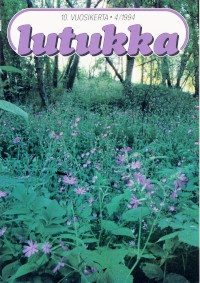 |
Tiivistelmät (englanniksi)
Vauras, J. & Kosonen, L. 1994: Viherukonsieni (Lepiota grangei) Suomessa - harvinainen ja uhanalainen. – Lutukka 10(3):67–71.
Lepiota grangei (Agaricales) in Finland - rare and threatened
Lepiota grangei (Eyre) Kühner is known from six sites in Finland, all in the southwestern part of the country, in the hemiboreal zone and in the southern part of the southern boreal zone. It grows in herb-rich deciduous forests, often dominated by Corylus avellana. Its ecology is treated, and its distribution in Finland is mapped. Lepiota grangei is classified as nationally threatened in Finland, in the category vulnerable. Squamanita contortipes (Smith & Stuntz) Heinemann & Thoen is reported as new to Finland.
Leht, M. 1994: Hankalia hanhikkeja. – Lutukka 10(3):72–76.
Troublesome cinquefoils
Among cinquefoils (Potentilla L.) growing in Estonia, Latvia and Lithuania, the most confusing ones for local botanists have been Potentilla intermedia L., P. heidenreichii Zimmeter and P. canescens Besser.
Potentilla intermedia L. was described as early as in 1767 and in 1860 Ruprecht separated from it P. intermedia ß. canescens Rupr., which in 1871 was assigned the rank of a species and named P. digitato-flabellata Heidenr. by F. A. Heidenreich. The same name had been used for an other taxon (P. digitato-flabellata A. Braun), and hence in 1884 Alber Zimmeter renamed the taxon as P. heidenreichii. This is now the valid name.
Potentilla intermedia and P. heidenreichii are European species which are distributed in Russia in the plant geographical regions of Ladoga-Ilmen, Upper-Dnieper, Volga-Kama and Volga-Don. In Scandinavia and Central Europe they are adventives and some authors consider them as such also in the Baltic states.
Potentilla heidenreichii is quite common in Estonia, Latvia and Lithuania while P. intermedia s.str. has only few localities there. The situation seems to be just the same in Finland. In NE Europe P. intermedia occurs in more localities than P. heidenreichii.
The best characteristics for distinguishing between P. heidenreichii and P. intermedia concern their leaflets: the leaflets of P. intermedia are thin, flat-margined, with only few straight hairs on both sides; the leaflets of P. heidenreichii are thicker, with margins slightly rolled down, pubescent above and more or less grey-tomentose (sericeous hairs) beneath and raised veins covered with straight hairs. Stems of P. intermedia are green and more branched than stems of P. heidenreichii, which are often reddish.
The variety of taxonomical viewpoints concerning P. intermedia and P. heidenreichii is accompanied by the problems of distinguishing between P. heidenreichii and P. canescens, and errors in their nomenclature, which are mostly mistakes in the use of synonyms.
Potentilla canescens is an Eurasian forest-steppe plant, which has been described from Western Ukraine. It grows on dry meadows, fallow lands, in steppes, on roadsides and slopes. Its main distribution area lies in Siberia, Ukraine, Caucasia, Central Asia and the Mediterranean region, but it reaches also Central Europe and Asia Minor. In Estonia and Latvia it is an adventive, which probably immigrated in the middle of the present century the first herbarium specimens being collected in the 1950s.
Potentilla canescens can be distinguished from P. heidenreichii by its simple erect stems and oblong-obovate leaflets with regular sharp teeth, both resembling those of P. recta (P. recta has much bigger flowers and sepals are covered with long straight hairs). The whole plant of P. canescens is hairy, often even grey-tomentose with long patent hairs. The leaves of P. heidenreichii lack long erec-to-patent hairs and the leaflets are irregularly toothed, the teeth being more or less obtuse.
The most interesting distribution pattern among Baltic cinquefoils occurs in a bit less troublesome but still confusing group consisting of P. crantzii (Crantz) G. Beck, P. neumanniana Reichenb. (P. tabernaemontani Ascherson), P. subarenaria Borbás and P. arenaria Borkh. (P. verna group).
Potentilla arenaria, P. subarenaria and P. neumanniana can be distinguished easily from each other using a loupe. Leaflets of P. arenaria are covered with stellate hairs only, which make the plant greyish; P. neumanniana has only simple straight hairs and P. subarenaria, which is considered to be of hybrid origin (P. arenaria × neumanniana), has straight hairs on the adaxial surface and stellate and straight hairs on the abaxial surface. The stellate hairs of P. arenaria may consist of up to 40 branches, while those of P. subarenaria have about 10 or less branches.
Potentilla crantzii is a northern species reaching its southern boundary in Latvia. P. neumanniana and P. subarenaria are quite common in western Estonia, where they sometimes grow even together on alvars, dry meadows, seashores and in juniper shrubs. P. neumanniana does not occur in Latvia and Lithuania. P. subarenaria has only two localities in Central Latvia and is absent from Lithuania. In Finland both species have some habitats on Åland and in the SW corner of the mainland. The other parent of Potentilla subarenaria, i.e. P. arenaria, is not present in Estonia, but occurs rather abundantly in central Latvia on sandy banks of the river Daugava, and in similar habitats in Lithuania.
Suominen, J. 1994: Ruotsinpitkäpalon, Arabidopsis suecica, syntyseudusta. – Lutukka 10(3):77–84.
On the area of origin for Arabidopsis suecica
The presumable origin of the Fennoscandian endemic, tetraploid (amphidiploid) Arabidopsis suecica, from two other species, the diploid A. thaliana and an unknown race of Cardaminopsis arenosa, is reviewed. There is also a theory that A. suecica arose, like some other polyploid endemics of hybrid origin, in front of the retreating glacier at the end of Ice Age about 10 000 years ago.
In preparing Atlas Florae Europaeae, the Swedish collaborators refused to consider A. suecica as certainly native (indigenous) anywhere in Sweden, and recent literature speaks in favour of such a view. On the other hand, there is no doubt that the plant is indigenous on rock outcrops within a large area of inland S Finland, probably just extending as such to Russia. This affects the theory in one respect: instead of two separate areas of origin, Finland and Sweden, we may have only one i.e. S(E) Finland.
The reason for the restricted indigenous range of A. suecica (including E Central Sweden or not) can be a demand of rock outcrops of the Fennoscandian Shield, perhaps joined with a subcontinental climate. The plant readily inhabits man-influenced sites like dry slopes and fallow fields of coarse soil, and it spreads along roads and railways. Thus the pattern of native occurrence is often obscured, and at least a locally widening secondary area is formed. The small isolated area reported from Germany is a puzzle so far (indigenous?, old or recent introduction?, misidentification?).
Ervi, L. O. & Raatikainen, M. 1994: Multian viljelykasveista, varsinkin luonnosta siirretyistä sekä viljelyjäänteistä ja -karkulaisista. – Lutukka 10(3):85–92.
Cultivated plants, cultivation relics and garden escapes in Multia, Central Finland
The vascular flora of the commune of Multia (766 km2) in Central Finland was studied in 1970-1975. Also cultivated plants, cultivation relics and garden escapes were recorded. The total number of plant species was about 555. 196 cultivated taxa were found out of doors. At least 43 wild Finnish plant species were cultivated. The numbers of taxa of cultivation relics and garden escapes were 77 and 38, respectively. The majority of the cultivated plants were brought or spread to Finland by man in the 1600s of earlier.
